
Work With Us
Private Coaching
Done-For-You
Short Courses
Client Reviews
Free Resources

How To Code Qualitative Data
Qualitative data coding explained simply – with examples.

A s we’ve discussed previously , qualitative research makes use of non-numerical data – for example, words, phrases or even images and video. To analyse this kind of data, the first dragon you’ll need to slay is qualitative data coding (or just “coding” if you want to sound cool). But what exactly is coding and how do you do it?
Overview: Qualitative Data Coding
In this post, we’ll explain qualitative data coding in simple terms. Specifically, we’ll dig into:
- What exactly qualitative data coding is
- What different types of coding exist
- How to code qualitative data (the process)
- Moving from coding to qualitative analysis
- Tips and tricks for quality data coding

What is qualitative data coding?
Let’s start by understanding what a code is. At the simplest level, a code is a label that describes the content of a piece of text. For example, in the sentence:
“Pigeons attacked me and stole my sandwich.”
You could use “pigeons” as a code. This code simply describes that the sentence involves pigeons.
So, building onto this, qualitative data coding is the process of creating and assigning codes to categorise data extracts. You’ll then use these codes later down the road to derive themes and patterns for your qualitative analysis (for example, thematic analysis ). Coding and analysis can take place simultaneously, but it’s important to note that coding does not necessarily involve identifying themes (depending on which textbook you’re reading, of course). Instead, it generally refers to the process of labelling and grouping similar types of data to make generating themes and analysing the data more manageable.
Makes sense? Great. But why should you bother with coding at all? Why not just look for themes from the outset? Well, coding is a way of making sure your data is valid . In other words, it helps ensure that your analysis is undertaken systematically and that other researchers can review it (in the world of research, we call this transparency). In other words, good coding is the foundation of high-quality analysis.

What are the different types of coding?
Now that we’ve got a plain-language definition of coding on the table, the next step is to understand what overarching types of coding exist – in other words, coding approaches . Let’s start with the two main approaches, inductive and deductive .
With deductive coding, you, as the researcher, begin with a set of pre-established codes and apply them to your data set (for example, a set of interview transcripts). Inductive coding on the other hand, works in reverse, as you create the set of codes based on the data itself – in other words, the codes emerge from the data. Let’s take a closer look at both.
Deductive coding 101
With deductive coding, we make use of pre-established codes, which are developed before you interact with the present data. This usually involves drawing up a set of codes based on a research question or previous research . You could also use a code set from the codebook of a previous study.
For example, if you were studying the eating habits of college students, you might have a research question along the lines of
“What foods do college students eat the most?”
As a result of this research question, you might develop a code set that includes codes such as “sushi”, “pizza”, and “burgers”.
Deductive coding allows you to approach your analysis with a very tightly focused lens and quickly identify relevant data . Of course, the downside is that you could miss out on some very valuable insights as a result of this tight, predetermined focus.

Inductive coding 101
But what about inductive coding? As we touched on earlier, this type of coding involves jumping right into the data and then developing the codes based on what you find within the data.
For example, if you were to analyse a set of open-ended interviews , you wouldn’t necessarily know which direction the conversation would flow. If a conversation begins with a discussion of cats, it may go on to include other animals too, and so you’d add these codes as you progress with your analysis. Simply put, with inductive coding, you “go with the flow” of the data.
Inductive coding is great when you’re researching something that isn’t yet well understood because the coding derived from the data helps you explore the subject. Therefore, this type of coding is usually used when researchers want to investigate new ideas or concepts , or when they want to create new theories.

A little bit of both… hybrid coding approaches
If you’ve got a set of codes you’ve derived from a research topic, literature review or a previous study (i.e. a deductive approach), but you still don’t have a rich enough set to capture the depth of your qualitative data, you can combine deductive and inductive methods – this is called a hybrid coding approach.
To adopt a hybrid approach, you’ll begin your analysis with a set of a priori codes (deductive) and then add new codes (inductive) as you work your way through the data. Essentially, the hybrid coding approach provides the best of both worlds, which is why it’s pretty common to see this in research.
Need a helping hand?
How to code qualitative data
Now that we’ve looked at the main approaches to coding, the next question you’re probably asking is “how do I actually do it?”. Let’s take a look at the coding process , step by step.
Both inductive and deductive methods of coding typically occur in two stages: initial coding and line by line coding .
In the initial coding stage, the objective is to get a general overview of the data by reading through and understanding it. If you’re using an inductive approach, this is also where you’ll develop an initial set of codes. Then, in the second stage (line by line coding), you’ll delve deeper into the data and (re)organise it according to (potentially new) codes.
Let’s take a look at these two stages of coding in more detail.
Step 1 – Initial coding
The first step of the coding process is to identify the essence of the text and code it accordingly. While there are various qualitative analysis software packages available, you can just as easily code textual data using Microsoft Word’s “comments” feature.
Let’s take a look at a practical example of coding. Assume you had the following interview data from two interviewees:
What pets do you have?
I have an alpaca and three dogs.
Only one alpaca? They can die of loneliness if they don’t have a friend.
I didn’t know that! I’ll just have to get five more.
I have twenty-three bunnies. I initially only had two, I’m not sure what happened.
In the initial stage of coding, you could assign the code of “pets” or “animals”. These are just initial, fairly broad codes that you can (and will) develop and refine later. In the initial stage, broad, rough codes are fine – they’re just a starting point which you will build onto in the second stage.

How to decide which codes to use
But how exactly do you decide what codes to use when there are many ways to read and interpret any given sentence? Well, there are a few different approaches you can adopt. The main approaches to initial coding include:
- In vivo coding
Process coding
- Open coding
Descriptive coding
Structural coding.
- Value coding
Let’s take a look at each of these:
In vivo coding
When you use in vivo coding , you make use of a participants’ own words , rather than your interpretation of the data. In other words, you use direct quotes from participants as your codes. By doing this, you’ll avoid trying to infer meaning, rather staying as close to the original phrases and words as possible.
In vivo coding is particularly useful when your data are derived from participants who speak different languages or come from different cultures. In these cases, it’s often difficult to accurately infer meaning due to linguistic or cultural differences.
For example, English speakers typically view the future as in front of them and the past as behind them. However, this isn’t the same in all cultures. Speakers of Aymara view the past as in front of them and the future as behind them. Why? Because the future is unknown, so it must be out of sight (or behind us). They know what happened in the past, so their perspective is that it’s positioned in front of them, where they can “see” it.
In a scenario like this one, it’s not possible to derive the reason for viewing the past as in front and the future as behind without knowing the Aymara culture’s perception of time. Therefore, in vivo coding is particularly useful, as it avoids interpretation errors.
Next up, there’s process coding , which makes use of action-based codes . Action-based codes are codes that indicate a movement or procedure. These actions are often indicated by gerunds (words ending in “-ing”) – for example, running, jumping or singing.
Process coding is useful as it allows you to code parts of data that aren’t necessarily spoken, but that are still imperative to understanding the meaning of the texts.
An example here would be if a participant were to say something like, “I have no idea where she is”. A sentence like this can be interpreted in many different ways depending on the context and movements of the participant. The participant could shrug their shoulders, which would indicate that they genuinely don’t know where the girl is; however, they could also wink, showing that they do actually know where the girl is.
Simply put, process coding is useful as it allows you to, in a concise manner, identify the main occurrences in a set of data and provide a dynamic account of events. For example, you may have action codes such as, “describing a panda”, “singing a song about bananas”, or “arguing with a relative”.

Descriptive coding aims to summarise extracts by using a single word or noun that encapsulates the general idea of the data. These words will typically describe the data in a highly condensed manner, which allows the researcher to quickly refer to the content.
Descriptive coding is very useful when dealing with data that appear in forms other than traditional text – i.e. video clips, sound recordings or images. For example, a descriptive code could be “food” when coding a video clip that involves a group of people discussing what they ate throughout the day, or “cooking” when coding an image showing the steps of a recipe.
Structural coding involves labelling and describing specific structural attributes of the data. Generally, it includes coding according to answers to the questions of “ who ”, “ what ”, “ where ”, and “ how ”, rather than the actual topics expressed in the data. This type of coding is useful when you want to access segments of data quickly, and it can help tremendously when you’re dealing with large data sets.
For example, if you were coding a collection of theses or dissertations (which would be quite a large data set), structural coding could be useful as you could code according to different sections within each of these documents – i.e. according to the standard dissertation structure . What-centric labels such as “hypothesis”, “literature review”, and “methodology” would help you to efficiently refer to sections and navigate without having to work through sections of data all over again.
Structural coding is also useful for data from open-ended surveys. This data may initially be difficult to code as they lack the set structure of other forms of data (such as an interview with a strict set of questions to be answered). In this case, it would useful to code sections of data that answer certain questions such as “who?”, “what?”, “where?” and “how?”.
Let’s take a look at a practical example. If we were to send out a survey asking people about their dogs, we may end up with a (highly condensed) response such as the following:
Bella is my best friend. When I’m at home I like to sit on the floor with her and roll her ball across the carpet for her to fetch and bring back to me. I love my dog.
In this set, we could code Bella as “who”, dog as “what”, home and floor as “where”, and roll her ball as “how”.
Values coding
Finally, values coding involves coding that relates to the participant’s worldviews . Typically, this type of coding focuses on excerpts that reflect the values, attitudes, and beliefs of the participants. Values coding is therefore very useful for research exploring cultural values and intrapersonal and experiences and actions.
To recap, the aim of initial coding is to understand and familiarise yourself with your data , to develop an initial code set (if you’re taking an inductive approach) and to take the first shot at coding your data . The coding approaches above allow you to arrange your data so that it’s easier to navigate during the next stage, line by line coding (we’ll get to this soon).
While these approaches can all be used individually, it’s important to remember that it’s possible, and potentially beneficial, to combine them . For example, when conducting initial coding with interviews, you could begin by using structural coding to indicate who speaks when. Then, as a next step, you could apply descriptive coding so that you can navigate to, and between, conversation topics easily. You can check out some examples of various techniques here .
Step 2 – Line by line coding
Once you’ve got an overall idea of our data, are comfortable navigating it and have applied some initial codes, you can move on to line by line coding. Line by line coding is pretty much exactly what it sounds like – reviewing your data, line by line, digging deeper and assigning additional codes to each line.
With line-by-line coding, the objective is to pay close attention to your data to add detail to your codes. For example, if you have a discussion of beverages and you previously just coded this as “beverages”, you could now go deeper and code more specifically, such as “coffee”, “tea”, and “orange juice”. The aim here is to scratch below the surface. This is the time to get detailed and specific so as to capture as much richness from the data as possible.
In the line-by-line coding process, it’s useful to code everything in your data, even if you don’t think you’re going to use it (you may just end up needing it!). As you go through this process, your coding will become more thorough and detailed, and you’ll have a much better understanding of your data as a result of this, which will be incredibly valuable in the analysis phase.

Moving from coding to analysis
Once you’ve completed your initial coding and line by line coding, the next step is to start your analysis . Of course, the coding process itself will get you in “analysis mode” and you’ll probably already have some insights and ideas as a result of it, so you should always keep notes of your thoughts as you work through the coding.
When it comes to qualitative data analysis, there are many different types of analyses (we discuss some of the most popular ones here ) and the type of analysis you adopt will depend heavily on your research aims, objectives and questions . Therefore, we’re not going to go down that rabbit hole here, but we’ll cover the important first steps that build the bridge from qualitative data coding to qualitative analysis.
When starting to think about your analysis, it’s useful to ask yourself the following questions to get the wheels turning:
- What actions are shown in the data?
- What are the aims of these interactions and excerpts? What are the participants potentially trying to achieve?
- How do participants interpret what is happening, and how do they speak about it? What does their language reveal?
- What are the assumptions made by the participants?
- What are the participants doing? What is going on?
- Why do I want to learn about this? What am I trying to find out?
- Why did I include this particular excerpt? What does it represent and how?

As with the initial coding and line by line coding, your qualitative analysis can follow certain steps. The first two steps are code categorisation and theme identification .
Code categorisation
Categorisation is simply the process of reviewing everything you’ve coded and then creating code categories that can be used to guide your future analysis. In other words, it’s about creating categories for your code set. Let’s take a look at a practical example.
If you were discussing different types of animals, your initial codes may be “dogs”, “llamas”, and “lions”. In the process of categorisation, you could label (categorise) these three animals as “mammals”, whereas you could categorise “flies”, “crickets”, and “beetles” as “insects”. By creating these code categories, you will be making your data more organised, as well as enriching it so that you can see new connections between different groups of codes.
From this categorisation, you can move onto the next step, which is to identify the themes in your data.
Theme identification
From the coding and categorisation processes, you’ll naturally start noticing themes. Therefore, the logical next step is to identify and clearly articulate the themes in your data set. When you determine themes, you’ll take what you’ve learned from the coding and categorisation and group it all together to develop themes. This is the part of the coding process where you’ll try to draw meaning from your data, and start to produce a narrative . The nature of this narrative depends on your research aims and objectives, as well as your research questions (sounds familiar?) and the qualitative data analysis method you’ve chosen, so keep these factors front of mind as you scan for themes.

Tips & tricks for quality coding
Before we wrap up, let’s quickly look at some general advice, tips and suggestions to ensure your qualitative data coding is top-notch.
- Before you begin coding, plan out the steps you will take and the coding approach and technique(s) you will follow to avoid inconsistencies.
- When adopting deductive coding, it’s useful to use a codebook from the start of the coding process. This will keep your work organised and will ensure that you don’t forget any of your codes.
- Whether you’re adopting an inductive or deductive approach, keep track of the meanings of your codes and remember to revisit these as you go along.
- Avoid using synonyms for codes that are similar, if not the same. This will allow you to have a more uniform and accurate coded dataset and will also help you to not get overwhelmed by your data.
- While coding, make sure that you remind yourself of your aims and coding method. This will help you to avoid directional drift , which happens when coding is not kept consistent.
- If you are working in a team, make sure that everyone has been trained and understands how codes need to be assigned.
Thanks for reading this post. We hope that you have a better understanding of the qualitative data coding process and that you’re feeling more confident about getting started. Good luck!
Learn More About Qualitative:

Triangulation: The Ultimate Credibility Enhancer
Triangulation is one of the best ways to enhance the credibility of your research. Learn about the different options here.

Structured, Semi-Structured & Unstructured Interviews
Learn about the differences (and similarities) between the three interview approaches: structured, semi-structured and unstructured.

Qualitative Coding Examples: Process, Values & In Vivo Coding
See real-world examples of qualitative data that has been coded using process coding, values coding and in vivo coding.

In Vivo Coding 101: Full Explainer With Examples
Learn about in vivo coding, a popular qualitative coding technique ideal for studies where the nuances of language are central to the aims.

Process Coding 101: Full Explainer With Examples
Learn about process coding, a popular qualitative coding technique ideal for studies exploring processes, actions and changes over time.
📄 FREE TEMPLATES
Research Topic Ideation
Proposal Writing
Literature Review
Methodology & Analysis
Academic Writing
Referencing & Citing
Apps, Tools & Tricks
The Grad Coach Podcast
33 Comments
I appreciated the valuable information provided to accomplish the various stages of the inductive and inductive coding process. However, I would have been extremely satisfied to be appraised of the SPECIFIC STEPS to follow for: 1. Deductive coding related to the phenomenon and its features to generate the codes, categories, and themes. 2. Inductive coding related to using (a) Initial (b) Axial, and (c) Thematic procedures using transcribe data from the research questions
Thank you so much for this. Very clear and simplified discussion about qualitative data coding.
This is what I want and the way I wanted it. Thank you very much.
All of the information’s are valuable and helpful. Thank for you giving helpful information’s. Can do some article about alternative methods for continue researches during the pandemics. It is more beneficial for those struggling to continue their researchers.
Thank you for your information on coding qualitative data, this is a very important point to be known, really thank you very much.
Very useful article. Clear, articulate and easy to understand. Thanks
This is very useful. You have simplified it the way I wanted it to be! Thanks
Thank you so very much for explaining, this is quite helpful!
hello, great article! well written and easy to understand. Can you provide some of the sources in this article used for further reading purposes?
You guys are doing a great job out there . I will not realize how many students you help through your articles and post on a daily basis. I have benefited a lot from your work. this is remarkable.
Wonderful one thank you so much.
Hello, I am doing qualitative research, please assist with example of coding format.
This is an invaluable website! Thank you so very much!
Well explained and easy to follow the presentation. A big thumbs up to you. Greatly appreciate the effort 👏👏👏👏
Thank you for this clear article with examples
Thank you for the detailed explanation. I appreciate your great effort. Congrats!
Ahhhhhhhhhh! You just killed me with your explanation. Crystal clear. Two Cheers!
D0 you have primary references that was used when creating this? If so, can you share them?
Being a complete novice to the field of qualitative data analysis, your indepth analysis of the process of thematic analysis has given me better insight. Thank you so much.
Excellent summary
Thank you so much for your precise and very helpful information about coding in qualitative data.
Thanks a lot to this helpful information. You cleared the fog in my brain.
Glad to hear that!
This has been very helpful. I am excited and grateful.
I still don’t understand the coding and categorizing of qualitative research, please give an example on my research base on the state of government education infrastructure environment in PNG
Wahho, this is amazing and very educational to have come across this site.. from a little search to a wide discovery of knowledge.
Thanks I really appreciate this.
Thank you so much! Very grateful.
This was truly helpful. I have been so lost, and this simplified the process for me.
Just at the right time when I needed to distinguish between inductive and
deductive data analysis of my Focus group discussion results very helpful
Very useful across disciplines and at all levels. Thanks…
Hello, Thank you for sharing your knowledge on us.
educative , simple and straightforward
Submit a Comment Cancel reply
Your email address will not be published. Required fields are marked *
Save my name, email, and website in this browser for the next time I comment.
Submit Comment
- Print Friendly

Coding Qualitative Data: How To Guide
A starting guide for coding qualitative data manually and automatically. Learn to build a coding frame and find significant themes in your data!
- Share on LinkedIn
- Share via Email
How many hours have you spent sitting in front of Excel spreadsheets trying to find new insights from customer feedback?
You know that asking open-ended survey questions gives you more actionable insights than asking your customers for just a numerical Net Promoter Score (NPS) . But when you ask open-ended, free-text questions, you end up with hundreds, thousands, or even more of free-text responses.
How can you turn all of that text into quantifiable, applicable information about your customers’ needs and expectations? By coding qualitative data.
In this article, we will cover different coding methods for qualitative data, including both manual and automated approaches, to provide a comprehensive understanding of the techniques used in the first-round pass at coding.
Keep reading to learn:
- What coding qualitative data means (and why it’s important)
- Different methods of coding qualitative data
- How to manually code qualitative data to find significant themes in your data
What is coding in qualitative research?
Conducting qualitative research, particularly through coding, is a crucial step in ensuring the validity and reliability of the findings. Coding is the process of labeling and organizing your qualitative data to identify different themes and the relationships between them.
When coding customer feedback , you assign labels to words or phrases that represent important (and recurring) themes in each response. These labels can be words, phrases, or numbers; we recommend using words or short phrases, since they’re easier to remember, skim, and organize.
Coding qualitative research to find common themes and concepts is part of thematic analysis . Thematic analysis extracts themes from text by analyzing the word and sentence structure.
Within the context of customer feedback, it’s important to understand the many different types of qualitative feedback a business can collect, such as open-ended surveys, social media comments, reviews & more.
What is qualitative data analysis?
Qualitative data analysis , including coding and analyzing qualitative data, is essential for understanding the depth and complexity of qualitative data. It is the process of examining and interpreting qualitative data to understand what it represents.
Qualitative analysis is crucial as it involves various methods such as thematic analysis, emotion coding, inductive and deductive thematic analysis, and content analysis. These methods help in coding the data, which is vital for the validity of the analysis.
Qualitative data is defined as any non-numerical and unstructured data; when looking at customer feedback, qualitative data usually refers to any verbatim or text-based feedback such as reviews, open-ended responses in surveys , complaints, chat messages, customer interviews, case notes or social media posts.
For example, NPS metric can be strictly quantitative, but when you ask customers why they gave you a rating a score, you will need qualitative data analysis methods in place to understand the comments that customers leave alongside numerical responses.
Methods of qualitative data analysis
Thematic analysis.
This refers to the uncovering of themes, by analyzing the patterns and relationships in a set of qualitative data. A theme emerges or is built when related findings appear to be meaningful and there are multiple occurrences. Thematic analysis can be used by anyone to transform and organize open-ended responses, analyze online reviews , and other qualitative data into significant themes. Thematic analysis coding is a method that aids in categorizing data extracts and deriving themes and patterns for qualitative analysis, facilitating the identification of themes revolving around a particular concept or phenomenon in the social sciences.
Content analysis:
This refers to the categorization, tagging and thematic analysis of qualitative data. Essentially content analysis is a quantification of themes, by counting the occurrence of concepts, topics or themes. Content analysis can involve combining the categories in qualitative data with quantitative data, such as behavioral data or demographic data, for deeper insights.
Narrative analysis:
Some qualitative data, such as interviews or field notes may contain a story on how someone experienced something. For example, the process of choosing a product, using it, evaluating its quality and decision to buy or not buy this product next time. The goal of narrative analysis is to turn the individual narratives into data that can be coded. This is then analyzed to understand how events or experiences had an impact on the people involved. Process coding is particularly useful in narrative analysis for identifying specific phases, sequences, and movements within the stories, capturing actions within qualitative data by using codes that typically represent gerunds ending in 'ing', providing a dynamic account of events within the data.
Discourse analysis:
This refers to analysis of what people say in social and cultural context. The goal of discourse analysis is to understand user or customer behavior by uncovering their beliefs, interests and agendas. These are reflected in the way they express their opinions, preferences and experiences. Structural coding is a method that can be applied here, organizing data based on predetermined structures, such as the structure of discourse elements, to enhance the analysis of discourse. It’s particularly useful when your focus is on building or strengthening a brand , by examining how they use metaphors and rhetorical devices.
Framework analysis:
When performing qualitative data analysis, it is useful to have a framework to organize the buckets of meaning. A taxonomy or code frame (a hierarchical set of themes used in coding qualitative data) is an example of the result. Don't fall into the trap of starting with a framework to make it faster to organize your data. You should look at how themes relate to each other by analyzing the data and consistently check that you can validate that themes are related to each other .
Grounded theory:
This method of analysis starts by formulating a theory around a single data case. Therefore the theory is “grounded' in actual data. Then additional cases can be examined to see if they are relevant and can add to the original theory.
Why is it important to code qualitative data?
Coding qualitative data makes it easier to interpret customer feedback. Assigning codes to words and phrases in each response helps capture what the response is about which, in turn, helps you better analyze and summarize the results of the entire survey.
Researchers use coding and other qualitative data analysis processes to help them make data-driven decisions based on customer feedback. When you use coding to analyze your customer feedback, you can quantify the common themes in customer language. This makes it easier to accurately interpret and analyze customer satisfaction.
What is thematic coding?
Thematic coding, also called thematic analysis, is a type of qualitative data analysis that finds themes in text by analyzing the meaning of words and sentence structure.
When you use thematic coding to analyze customer feedback for example, you can learn which themes are most frequent in feedback. This helps you understand what drives customer satisfaction in an accurate, actionable way.
To learn more about how Thematic analysis software helps you automate the data coding process, check out this article .
Automated vs. Manual coding of qualitative data
Methods of coding qualitative data fall into three categories: automated coding and manual coding, and a blend of the two.
You can automate the coding of your qualitative data with thematic analysis software . Thematic analysis and qualitative data analysis software use Artificial Intelligence (AI) , Natural Language Processing (NLP) to code your qualitative data and break text up into themes.
The BEST thematic analysis software is autonomous , which means…
- You don't need to set up themes or categories in advance.
- You don't need to train the algorithm — it learns on its own.
- You can easily capture the “unknown unknowns” to identify themes you may not have spotted on your own.
…all of which will save you time (and lots of unnecessary headaches) when analyzing your customer feedback.
Businesses are also seeing the benefit of using thematic analysis software. The capacity to aggregate data sources into a single source of analysis helps to break down data silos, unifying the analysis and insights across departments . This is now being referred to as Omni channel analysis or Unified Data Analytics .
Use Thematic Analysis Software
Whether you have tons of customer reviews, support chat, customer service conversations ( conversational analytics ) or open-ended survey responses, thematic analysis software like Thematic bring every valuable insight to the surface, while saving you thousands of hours.
Advances in AI have made it possible to automate the analysis of qualitative data, in particular content and framework analysis. Tools like ChatGPT and CoPilot are widely used for coding qualitative data on a small scale. Specialized solutions for this task are often referred to as text analytics software such as Thematic .
There are many benefits of automation:
- Scale. You can analyze much more qualitative data, which will make your insights more detailed and robust.
- Bias control. You are less likely to miss things than when you analyze data manually. Bias and other errors are likely to creep in when you are tired or in a rush.
- Time saving. You can focus on more high-value tasks that are more interesting, or save money required to hire dedicated coding resources.
Automating most of the analysis became the preferred choice for users. But no matter what solution you use, human oversight is still required to verify the accuracy. For example, Thematic has a Themes Editor tool which makes this oversight easy. It has drag-and-drop functionality and it makes it easy to refine, validate, and rename themes as you get more data. By guiding the AI, you can ensure your results are always precise, easy to understand and perfectly aligned with your objectives.
Thematic is the best software to automate code qualitative feedback at scale.
Don't just take it from us. Here's what some of our customers have to say:
I'm a fan of Thematic's ability to save time and create heroes. It does an excellent job using a single view to break down the verbatims into themes displayed by volume, sentiment and impact on our beacon metric, often but not exclusively NPS.
It does a superlative job using GenAI in summarizing a theme or sub-theme down to a single paragraph making it clear what folks are trying to say. Peter K, Snr Research Manager.
Thematic is a very intuitive tool to use. It boasts a robust level of granularity, allowing the user to see the general breadth of verbatim themes, dig into the sub-themes, and further into the sentiment of the open text itself. Artem C, Sr Manager of Research. LinkedIn.
AI-powered software to transform qualitative data at scale through a thematic and content analysis.
How to manually code qualitative data
For the rest of this post, we'll focus on manual coding. Different researchers have different processes, but manual coding usually looks something like this:
- Choose whether you'll use deductive or inductive coding.
- Read through your data to get a sense of what it looks like. Assign your first set of codes.
- Go through your data line-by-line to code as much as possible. Your codes should become more detailed at this step.
- Categorize your codes and figure out how they fit into your coding frame.
- Identify which themes come up the most — and act on them.
Let's break it down a little further…
Deductive coding vs. inductive coding
Before you start qualitative data coding, you need to decide which codes you'll use.
What is Deductive Coding?
Deductive coding means you start with a predefined set of codes, then assign those codes to the new qualitative data. These codes might come from previous research, or you might already know what themes you're interested in analyzing. Deductive coding is also called concept-driven coding.
For example, let's say you're conducting a survey on customer experience . You want to understand the problems that arise from long call wait times, so you choose to make “wait time” one of your codes before you start looking at the data.
The deductive approach can save time and help guarantee that your areas of interest are coded. But you also need to be careful of bias; when you start with predefined codes, you have a bias as to what the answers will be. Make sure you don't miss other important themes by focusing too hard on proving your own hypothesis.
What is Inductive Coding?
Inductive coding , also called open coding, starts from scratch and creates codes based on the qualitative data itself. You don't have a set codebook; all codes arise directly from the survey responses.
Here's how inductive coding works:
- Break your qualitative dataset into smaller samples.
- Read a sample of the data.
- Create codes that will cover the sample.
- Reread the sample and apply the codes.
- Read a new sample of data, applying the codes you created for the first sample.
- Note where codes don't match or where you need additional codes.
- Create new codes based on the second sample.
- Go back and recode all responses again.
- Repeat from step 5 until you've coded all of your data.
If you add a new code, split an existing code into two, or change the description of a code, make sure to review how this change will affect the coding of all responses. Otherwise, the same responses at different points in the survey could end up with different codes.
Sounds like a lot of work, right? Inductive coding is an iterative process, which means it takes longer and is more thorough than deductive coding. A major advantage is that it gives you a more complete, unbiased look at the themes throughout your data.
Combining inductive and deductive coding
In practice, most researchers use a blend of inductive and deductive approaches to coding.
For example, with Thematic, the AI inductively comes up with themes , while also framing the analysis so that it reflects how business decisions are made . At the end of the analysis, researchers use the Theme Editor to iterate or refine themes. Then, in the next wave of analysis, as new data comes in, the AI starts deductively with the theme taxonomy.
Categorize your codes with coding frames
Once you create your codes, you need to put them into a coding frame. A coding frame represents the organizational structure of the themes in your research. There are two types of coding frames: flat and hierarchical.
Flat Coding Frame
A flat coding frame assigns the same level of specificity and importance to each code. While this might feel like an easier and faster method for manual coding, it can be difficult to organize and navigate the themes and concepts as you create more and more codes. It also makes it hard to figure out which themes are most important, which can slow down decision making.
Hierarchical Coding Frame
Hierarchical frames help you organize codes based on how they relate to one another. For example, you can organize the codes based on your customers' feelings on a certain topic:

Hierarchical Coding Frame example
In this example:
- The top-level code describes the topic (customer service)
- The mid-level code specifies whether the sentiment is positive or negative
- The third level details the attribute or specific theme associated with the topic
Hierarchical framing supports a larger code frame and lets you organize codes based on organizational structure. It also allows for different levels of granularity in your coding.
Whether your code frames are hierarchical or flat, your code frames should be flexible. Manually analyzing survey data takes a lot of time and effort; make sure you can use your results in different contexts.
For example, if your survey asks customers about customer service, you might only use codes that capture answers about customer service. Then you realize that the same survey responses have a lot of comments about your company's products. To learn more about what people say about your products, you may have to code all of the responses from scratch! A flexible coding frame covers different topics and insights, which lets you reuse the results later on.
Tips for manually coding qualitative data
Now that you know the basics of coding your qualitative data, here are some tips on making the most of your qualitative research.
Use a codebook to keep track of your codes
As you code more and more data, it can be hard to remember all of your codes off the top of your head. Tracking your codes in a codebook helps keep you organized throughout the data analysis process. Your codebook can be as simple as an Excel spreadsheet or word processor document. As you code new data, add new codes to your codebook and reorganize categories and themes as needed.
Make sure to track:
- The label used for each code
- A description of the concept or theme the code refers to
- Who originally coded it
- The date that it was originally coded or updated
- Any notes on how the code relates to other codes in your analysis
How to create high-quality codes - 4 tips
1. cover as many survey responses as possible..
The code should be generic enough to apply to multiple comments, but specific enough to be useful in your analysis. For example, “Product” is a broad code that will cover a variety of responses — but it's also pretty vague. What about the product? On the other hand, “Product stops working after using it for 3 hours” is very specific and probably won't apply to many responses. “Poor product quality” or “short product lifespan” might be a happy medium.
2. Avoid commonalities.
Having similar codes is okay as long as they serve different purposes. “Customer service” and “Product” are different enough from one another, while “Customer service” and “Customer support” may have subtle differences but should likely be combined into one code.
3. Capture the positive and the negative.
Try to create codes that contrast with each other to track both the positive and negative elements of a topic separately. For example, “Useful product features” and “Unnecessary product features” would be two different codes to capture two different themes.
4. Reduce data — to a point.
Let's look at the two extremes: There are as many codes as there are responses, or each code applies to every single response. In both cases, the coding exercise is pointless; you don't learn anything new about your data or your customers. To make your analysis as useful as possible, try to find a balance between having too many and too few codes.
Group responses based on themes, not words
Make sure to group responses with the same themes under the same code, even if they don't use the same exact wording. For example, a code such as “cleanliness” could cover responses including words and phrases like:
- Looked like a dump
- Could eat off the floor
Having only a few codes and hierarchical framing makes it easier to group different words and phrases under one code. If you have too many codes, especially in a flat frame, your results can become ambiguous and themes can overlap. Manual coding also requires the coder to remember or be able to find all of the relevant codes; the more codes you have, the harder it is to find the ones you need, no matter how organized your codebook is.
Make accuracy a priority
Manually coding qualitative data means that the coder's cognitive biases can influence the coding process. For each study, make sure you have coding guidelines and training in place to keep coding reliable, consistent, and accurate .
One thing to watch out for is definitional drift, which occurs when the data at the beginning of the data set is coded differently than the material coded later. Check for definitional drift across the entire dataset and keep notes with descriptions of how the codes vary across the results.
If you have multiple coders working on one team, have them check one another's coding to help eliminate cognitive biases.
Conclusion: 6 main takeaways for coding qualitative data
Here are 6 final takeaways for manually coding your qualitative data:
- Coding is the process of labeling and organizing your qualitative data to identify themes. After you code your qualitative data, you can analyze it just like numerical data.
- Inductive coding (without a predefined code frame) is more difficult, but less prone to bias, than deductive coding.
- Code frames can be flat (easier and faster to use) or hierarchical (more powerful and organized).
- Your code frames need to be flexible enough that you can make the most of your results and use them in different contexts.
- When creating codes, make sure they cover several responses, contrast one another, and strike a balance between too much and too little information.
- Consistent coding = accuracy. Establish coding procedures and guidelines and keep an eye out for definitional drift in your qualitative data analysis.
Some more detail in our downloadable guide
If you've made it this far, you'll likely be interested in our free guide: Best practices for analyzing open-ended questions.
The guide includes some of the topics covered in this article, and goes into some more niche details.
If your company is looking to automate your qualitative coding process, try Thematic !
If you're looking to trial multiple solutions, check out our free buyer's guide . It covers what to look for when trialing different feedback analytics solutions to ensure you get the depth of insights you need.
Happy coding!

Alyona Medelyan PhD Twitter
Alyona has a PhD in NLP and Machine Learning. Her peer-reviewed articles have been cited by over 2600 academics. Her love of writing comes from years of PhD research.
Thematic Newsletter
Join the newsletter to receive the latest updates in your inbox.
You might also like
Thematic analysis: an overview + guide paid members public.
Discover the power of thematic analysis to unlock insights from qualitative data. Learn about manual vs. AI-powered approaches, best practices, and how Thematic software can revolutionize your analysis workflow.
How To Use Thematic Analysis AI To Theme Qualitative Data Paid Members Public
Become a qualitative theming pro! Creating a perfect code frame is hard, but thematic analysis software makes the process much easier.
Voice of Customer Examples: How Different Industries Use VoC Insights Paid Members Public
Explore real-world examples of how various industries can use voice of the customer (VOC) insights to improve CX and business performance.
Get started with a guided trial on your data
Experience the power of AI
Table of Contents
Featured posts, social media sentiment analysis: simple guide + best tools.

How to validate your AI-driven insights

Scale or fail: Building an infinite customer feedback loop with AI

Analyze Qualitative Data. At Scale.
Complete guide to coding for qualitative research.
Home » Complete Guide to Coding for Qualitative Research
Qualitative coding is a vital process in transforming raw data into meaningful insights. As researchers dive deep into the nuances of human behavior and experiences, understanding how to effectively code qualitative data becomes imperative. This guide serves to illuminate the path for both novice and experienced researchers, enabling them to unravel themes and patterns that emerge from their qualitative findings.
In this section, we will explore the fundamentals of qualitative coding, including its purpose, methodology, and application. By adhering to a structured approach, you can enhance the reliability and comprehensiveness of your research. Whether you are analyzing interview transcripts or focus group discussions, mastering qualitative coding will empower you to draw actionable conclusions that resonate beyond mere numbers.
Understanding the Basics of Qualitative Coding
Qualitative coding is essential for analyzing interviews, focus groups, and open-ended survey responses. It involves categorizing textual data into meaningful themes or codes, which helps researchers identify patterns. This process is crucial for drawing insights from qualitative research , where the richness of data requires careful handling. Understanding the basics of qualitative coding begins with recognizing its role in the research process. It transforms raw data into structured information that can inform decisions and strategies.
To get started with qualitative coding, consider the following steps:
- Familiarize Yourself with Your Data : Read through your transcripts or notes to grasp the overall context.
- Identify Initial Concepts : Highlight recurring ideas or themes that emerge during your reading.
- Develop Codes : Create labels for these themes, ensuring they accurately reflect the content.
- Organize the Codes : Group similar codes together to form more comprehensive categories.
- Review and Refine : Continuously assess your coding framework as new insights emerge, allowing for adjustments as necessary.
By following these steps, you can navigate the complexities of qualitative coding effectively. This qualitative coding guide equips you with the foundation to delve deep into your research data and uncover essential insights.

What is Qualitative Coding?
Qualitative coding is an essential process in qualitative research, aimed at identifying themes and patterns within data. This method involves systematically organizing text, interviews, or other unstructured data to extract meaningful insights. By categorizing responses, researchers can better understand participants’ thoughts and experiences, leading to richer conclusions. It ensures that the voices of participants are accurately reflected in the analysis.
In this Qualitative Coding Guide, we break down the steps involved in effective coding. First, familiarize yourself with your data, ensuring you understand its context. Next, develop a coding scheme that outlines your categories or themes. After that, apply this scheme to your data while remaining open to new themes that may emerge during analysis. Finally, review and refine your codes, ensuring consistency and accuracy. This structured approach will enhance your qualitative research and lead to valuable insights.
Why is Qualitative Coding Important?
Qualitative coding is vital for systematically understanding qualitative data. It allows researchers to categorize, summarize, and interpret complex information from interviews, surveys, or other sources. By identifying patterns and themes within the data, qualitative coding transforms raw information into meaningful insights that inform decision-making and strategy development.
There are several critical reasons why qualitative coding holds importance. First, it enhances data analysis , enabling a more structured approach to derive conclusions. Second, coding fosters consistency, ensuring that interpretations remain aligned across different researchers or study phases. Third, it allows for the emergence of unexpected insights that can guide future research or adjustments to existing frameworks. Ultimately, a solid Qualitative Coding Guide lays the foundation for rigorous qualitative research, supporting researchers in achieving clear, actionable results.
Enhancing Data Analysis
To enhance data analysis in qualitative research, it is essential to adopt structured coding methodologies. These methodologies can transform raw data into actionable insights. By implementing systematic coding practices, you can uncover consistent themes within the data, aiding in deeper interpretation and understanding of the subjects studied. These processes can also streamline workflows, making it easier to visualize trends and patterns that emerge from participant responses.
One effective strategy is to cluster codes into categories, allowing for a comprehensive overview. Additionally, employing software tools can automate certain aspects of data analysis, saving time and increasing accuracy. Collaborating with peers during the coding process can foster richer discussions and diverse perspectives. Ultimately, enhancing data analysis means refining your approach and ensuring insights are relevant and can lead to informed decision-making. This qualitative coding guide will help you navigate these essential strategies for successful analysis.
Facilitating Pattern Recognition
Facilitating pattern recognition in qualitative research is essential for drawing meaningful insights from data. When coding qualitative data, researchers can apply various techniques to identify recurring themes and patterns effectively. Using consistent coding strategies ensures that similar ideas are grouped together, making it easier to analyze extensive datasets.
There are key steps to facilitate pattern recognition in qualitative coding. First, familiarize yourself with the core data, identifying key phrases and concepts that stand out. Next, utilize coding frameworks to categorize these insights effectively. Third, engage in constant comparison to refine your categories as new data emerges. Lastly, review coded data regularly to identify broader patterns that may have initially gone unnoticed. This iterative process not only enhances understanding but also contributes to more robust findings in your qualitative analysis. Following this Qualitative Coding Guide equips researchers to uncover significant trends that can drive impactful conclusions.
Steps in the Qualitative Coding Guide Process
The Qualitative Coding Guide process involves several essential steps to ensure systematic analysis of qualitative data. Firstly, familiarize yourself with the data sources, such as interviews or focus groups, and transcribe them for easier analysis. This transcription should then be reviewed for initial insights, as familiarization with the content is crucial for effective coding.
Next, establish coding categories based on your research questions and objectives, allowing you to organize your findings. Once categories are set, apply them to your data, highlighting relevant themes and patterns. Lastly, refine and revise your codes continually, ensuring they accurately reflect the data's richness. This iterative process aids in uncovering deeper insights and supports the overall goal of qualitative research. By following these steps, researchers can effectively navigate the complexities of qualitative coding and yield meaningful results.
Preparing Your Data
Preparing your data is a crucial step in the qualitative coding process. Begin by organizing your materials and cleaning any extraneous content that may obscure your insights. This might include transcribing interviews, categorizing survey responses, or compiling focus group discussions. Each dataset should be clearly labeled and systematically arranged to facilitate the coding process. This structured approach enhances your ability to extract meaningful patterns and themes, which are central to qualitative research.
Next, consider differentiating between raw data and analyzed data. Raw data includes everything collected during your research phase, while analyzed data comprises the insights drawn from this raw material. A clear distinction helps you maintain focus on both the details and the broader themes during coding. Effectively preparing your data will streamline your workflow and lay a solid foundation for a thorough and insightful qualitative coding experience.
Transcribing Interviews and Focus Groups
Transcribing interviews and focus groups is a crucial step in qualitative research. This process involves converting spoken dialogue into written text, ensuring clarity and accuracy. The transcription serves as the foundation for subsequent coding and analysis, allowing researchers to identify themes and patterns within the data effectively. By meticulously documenting the conversations, researchers can capture nuances, tone, and context, which are vital for drawing meaningful insights.
To enhance the transcription process, consider the following key practices. First, utilize transcription software or services designed for speed and accuracy, reducing manual effort. Second, establish a standard format for transcriptions that includes speaker tags and timestamps for reference. Third, review and edit the transcripts to correct any inaccuracies or ambiguous phrases. Finally, ensure confidentiality by anonymizing participant details where necessary. By following these guidelines, researchers can streamline their workflow, making it easier to analyze qualitative data in line with the principles outlined in this qualitative coding guide.
Organizing Data Files
Organizing data files is a crucial step in qualitative research, as it lays the foundation for effective coding and analysis. When data is well-organized, it's easier to identify patterns and extract meaningful insights. Start by categorizing data based on themes or research questions. This might involve creating subfolders for different locations or individual performance metrics, ensuring that you can quickly navigate through the information when needed.
Next, consider implementing a consistent naming convention for your files. Use clear, descriptive titles that reflect the content, making it simpler to locate specific files. Additionally, maintain a version control system to track changes over time. This approach not only preserves the integrity of your data but also enables collaboration with team members. An organized data file structure enhances your coding process, ultimately guiding you through the qualitative analysis with clarity and efficiency.
Coding Your Data
Coding your data is a crucial step in qualitative research, allowing researchers to make sense of the information collected. By organizing and categorizing responses, you create a framework that reveals patterns and insights. This process transforms raw data into a format that can be analyzed and interpreted effectively. Begin by familiarizing yourself with the types of coding methods—open coding, axial coding, and selective coding are essential to the qualitative coding guide.
Next, you must develop a coding scheme. A thorough understanding of your research questions will inform this process. Create codes that accurately reflect the themes emerging from your data. It’s vital to remain flexible throughout this phase, as new insights might lead to adjustments in your coding structure. Review and refine your codes consistently, ensuring they effectively represent the data. Ultimately, effective coding lays the foundation for meaningful analysis and contributes to richer findings in qualitative research.
Initial Coding Techniques
Initial coding techniques are essential in qualitative research as they lay the groundwork for deeper analysis. These techniques allow researchers to break down vast amounts of data into manageable segments, facilitating the identification of patterns and themes. By systematically coding responses, researchers can capture crucial insights that might otherwise be overlooked.
One useful approach is to start with open coding, where you note down initial impressions and keywords that represent core concepts. Another technique is axial coding, where you refine these initial codes by connecting them to broader categories. Finally, selective coding helps you integrate and refine your findings into a coherent narrative. These steps enhance the accuracy and reliability of the qualitative analysis, making the initial coding phase a critical part of any qualitative coding guide. By employing these techniques, researchers can ensure that their findings are grounded in the data, resulting in meaningful conclusions.
Advanced Coding Strategies
Advanced coding strategies enhance qualitative research by refining the organization and interpretation of data. An effective approach involves thematic coding, which identifies and categorizes prominent patterns within the data. This method allows researchers to distill complex information into manageable themes that reveal insightful connections and trends. Moreover, focused coding, which emphasizes specific segments of text, can offer clarity and depth in analysis.
Employing these strategies promotes a richer understanding of qualitative data. Researchers can also integrate member checking, soliciting feedback from participants to ensure accuracy and relevance. This fosters trustworthiness in findings and invites participants into the analysis process. Finally, triangulation—utilizing multiple data sources—can enrich interpretations and strengthen conclusions. By adopting these advanced coding strategies, researchers not only improve data analysis but also enhance the overall rigor of their qualitative research.
Conclusion: Mastering the Qualitative Coding Guide
Mastering the qualitative coding guide is essential for researchers aiming to distill meaningful insights from their data. This process not only facilitates thorough analysis but also enhances the reliability of findings by ensuring consistency in coding. As researchers engage with various themes, their understanding deepens, transforming raw data into actionable insights.
By effectively applying qualitative coding techniques, researchers can better evaluate their frameworks and performance metrics. The goal should be to create a robust framework that measures the quality of interactions while refining the coding process. Mastery in qualitative coding ultimately leads to a richer understanding of user experiences, enhancing both service delivery and overall research outcomes.
Turn conversations into actionable insights
On this Page
The Process of Business Research: Step-by-Step Instructions
You may also like, content analysis example in research settings.
Content Analysis Advantages and Disadvantages
Content analysis coding scheme explained.
Unlock Insights from Interviews 10x faster
- See a Live demo
- Start Analyzing Free
Our CEO, Odun Odubanjo introduces new tools that simplify and enhance conversation analysis at scale. With Project Kits and a Visual Designer, Insight7 now makes it easier than ever to turn conversations into actionable insights and assets.
How to Do Pattern Coding in Qualitative Research

This is part of our Essential Guide to Coding Qualitative Data | Start a Free Trial of Delve | Take Our Free Online Qualitative Data Analysis Course
Pattern coding is all about weaving the mess of your initial coding rounds into broader categories or themes, like sorting a list of your favorite songs into playlists by mood or genre.
In the aftermath of initial coding, you’re often left drowning in a sea of separate codes and side notes. Pattern coding helps you package all these loose ideas and tell a story to explain what it all means in your write up.
While “packaging” your initial code might sound easy enough, a lot of intentional decisions go into deciding when, where, and how to draw your dividing lines. Pattern coding offers a proven framework for this process.
This article walks you through pattern coding, how to avoid common roadblocks, and how tools like Delve computer-assisted qualitative data analysis software (CAQDAS) set you up for more efficient and rigorous pattern coding results.
💡 Are you just beginning with qualitative analysis and coding? Consider starting with The Practical Guide to Qualitative Analysis – or take our Free Qualitative Analysis Course for Beginners .
Pattern Coding: A Key Step in Qualitative Analysis

As a new researcher diving into qualitative analysis, you'll encounter various coding techniques. Pattern coding is a primary method that helps you make sense of your initial study findings and develop deeper insights.
Understanding Where Pattern Coding Fits in the Qualitative Coding Process
Qualitative coding involves labeling and organizing non-numerical data like interviews or focus groups. Johnny Saldaña outlines a two-part process in "The Coding Manual for Qualitative Researchers" (2015) , with pattern coding taking place in the second part of the process.:
1. Initial coding (first-cycle) : This is your first pass through the data. It is usually fast and loose, breaking into manageable chunks that are easier to work with.
Learn About First-Cycle Coding
- In vivo coding : Using participants' own words as codes.
- Structural coding : Coding based on specific research questions.
- Process coding : Identifying actions or processes in the data.
- Open coding : Breaking data into discrete parts for analysis.
2. Pattern coding (second-cycle) : Now, you “re-code” and synthesize your initial codes to identify larger themes, concepts, or categories.
Your first-cycle methods break down piles of raw data into manageable parts. But to dive deeper into meaning and identify broader patterns across your data, you’ll need to take it a step further with second-cycle methods like pattern coding.
What is Pattern Coding in Qualitative Research?

With your messy initial coding complete, pattern coding is the next stage where you’re re-coding and creating “meta-codes.” You’re looking to understand more about existing data like how existing codes relate to each other and why those relationships occur .
The goal of pattern coding is to:
Identify connections between your initial codes
Group related ideas
Eliminate redundancy
Develop richer, more cohesive results
Your pattern codes ultimately bridge initial codes to your final analysis, making it easier to lay out and explain in your final write up or thesis.
⏳ Coding Tip: Saldaña specifically suggests using CAQDAS for pattern coding instead of manual techniques like pen and paper, Microsoft Word, or Excel. Delve offers features like data filtering , drag-and-drop coding , and visualization tools that help you develop richer pattern codes in less time without all the organizational bottlenecks.
Basic Pattern Coding Workflow
With pattern coding, you move from labeling specific details to spotting broader themes that come together in the data.
Start with your batch of first-cycle codes, possibly dozens or even hundreds.
Cluster these codes into smaller categories based on patterns you find (more on this soon).
Develop "meta-codes" or pattern codes that capture the essence of these categories. You’re transitioning from specific details and zooming out to spot larger themes or ideas that pool together.
Use these pattern codes to construct the narrative of your study.
Think of pattern coding like you’re zooming out from inside the maze of initial codes to look at things from a birds-eye view.
QUICK EXAMPLE OF PATTERN CODING
Saldaña’s book offers a simple pattern coding example that starts with a batch of initial codes collected from staff interview transcripts.
First-Cycle Codes
- • Unclear Instructions
- • Rushed Directions
- • Incomplete Directions
- • Expectations of Information
- • "She Doesn't Communicate"
- • Written Directions Needed
- • "You Never Told Me"
The next image shows how easy it is to drag, drop, mix, and match codes to create this pattern code in Delve :
In a few clicks, these initial codes have been grouped under the more inferential pattern code of "Dysfunctional Direction" .
⚠️ Try not to oversimplify. Pattern codes should be specific enough to be meaningful, but broad enough to capture a pattern across data. "Communication Issues" is too broad. "Dysfunctional Direction" gives additional insight.
When to Use Pattern Coding
That brings us to when you should actually use pattern coding in a qualitative research project. Beyond just organizing your data, it’s particularly useful when you need to:
Go Beyond Surface-Level Analysis : To uncover hidden patterns or relationships in your data. For grounded theory or thematic analysis , pattern coding connects the analytical dots in less obvious ways. In our earlier example, instead of just grouping complaints, it could have helped flesh out "Dysfunctional Direction" as a deeper communication issue within the office.
Identify Underlying Causes : Understanding the reasons behind certain behaviors or trends is hard. Imagine trying to find the main plot across hundreds of different news articles in content analysis . Pattern coding moves you from simply categorizing data to interpreting its deeper meaning. Going back to "Dysfunctional Direction," this pattern code pointed to a systemic communication issue rather than just isolated complaints.
CRASH COURSE | IDENTIFYING UNDERLYING CAUSES
John: "I often get unclear instructions from my manager, and they're always rushed . It’s hard to know exactly what they want, and I end up feeling lost."
Emily: "Sometimes, I don’t get the full details and have to ask for incomplete directions to be clarified."
Ben: "There's this unspoken expectation of information that I should just know, even though they never tell me everything upfront."
Initially Coded Data:
- Unclear Instructions
- Rushed Directions
- Incomplete Directions
- Expectation of Information
Pattern Code:
Dysfunctional Direction — These individual complaints initially seemed disconnected, but pattern coding led the team to a broader systemic issue in how management delivered instructions. This showed the communication problems were part of a larger pattern affecting the organization and not isolated incidents.
Reveal Complex Relationships : Study multiple variables or intricate relationships. Pattern coding can help you clarify how these elements interact and influence each other. If you’re conducting discourse analysis for example, you might find that informal chats combined with frequent meetings strengthen workplace relationships more than either one alone.
Develop More Rigorous Insights : If you’re aiming to refine your analysis and draw out more sophisticated conclusions, pattern coding helps you distill the data into fully interconnected ideas. In our example, you could use it to show how different communication channels work together to impact overall team productivity.
Enhance Collaboration : When working in a team, pattern coding keeps everyone on the same page by standardizing how data is categorized and interpreted. Learn how to do better collaborative qualitative analysis with Delve .
Creating pattern codes is really all about finding deep-seated connections between your data. In our example, pattern coding turned individual complaints into a clear systemic issue. Pattern coding can be used any time you need to dig for these deeper insights in your scattered initial analysis.
⏳ Coding Tip: With Delve , you can create customizable code hierarchies to group related codes and track their evolution over time. This feature ensures your pattern coding stays flexible and scalable as your analysis progresses.
How to Create Pattern Codes

But when it comes time to get to work, how do you actually create your pattern codes ?
While there's no one-size-fits-all method, Saldaña suggests focusing on three main concepts to guide your pattern-seeking process: themes, explanations, and relationships among people or groups . Think of these as different lenses to cluster and interpret your codes.
Concepts For Clustering Codes in Meaningful Ways:
- Themes: Organizing data into broader topics that recur throughout your dataset.
- Explanations: Providing insights into the causes behind your observations.
- Relationships Among People or Groups: Examining social networks and patterns of interaction in your research.
Core Concepts For Creating Pattern Codes
Let's walk through each concept in more detail, using clear examples to illustrate how you might apply them in your own pattern coding.
What They Are: Themes are big ideas or topics that appear repeatedly throughout your data. They help you categorize your findings into coherent groups that capture the essence of what's being discussed.
Example: Suppose you're analyzing interviews about employee satisfaction in the workplace. Some of your initial codes might be:
"Flexible Hours"
"Work-Life Balance"
"Supportive Management"
"Career Advancement"
"Positive Work Environment"
You might cluster these codes under the theme "Job Satisfaction Factors." Learn more about generating themes here:
⚠️ Best Practice : Remember not to oversimplify. Themes should be specific enough to be meaningful. Instead of a vague theme like "Good Stuff," use something more descriptive like "Job Satisfaction Factors."
2. EXPLANATIONS
What They Are: Explanations offer reasons behind what you're observing in your data. They help you understand causes and answer "why" questions.
Example: Continuing with the workplace study, suppose you notice codes like:
"Unclear Instructions"
"Lack of Feedback"
"Micromanagement"
“You Never Told Me”
"High Turnover"
This is where you might develop an explanation pattern code such as “Dysfunctional Direction,” which helps explain why employees are experiencing dissatisfaction or frustration. Another option would be "Ineffective Leadership Practices."
💡 Best Practice: Focus on identifying the underlying causes behind your data. A good explanation code should go beyond what’s happening to answer why it’s happening, offering deeper insight into patterns of behavior or trends.
3. RELATIONSHIPS AMONG PEOPLE OR GROUPS
What They Are: This concept focuses on how individuals or groups interact and influence each other within your research context. It highlights social dynamics and networks significant in your data.
Example: From your interviews, you might have codes like:
"Team Collaboration"
"Mentorship Programs"
"Peer Support"
"Interdepartmental Conflicts"
You could create a pattern code "Workplace Relationships" to explore how these interactions impact the work environment. Or, you might develop more specific pattern codes like "Supportive Team Dynamics" or "Communication Barriers Between Departments," depending on what your data reveals.
💡 Best Practice: Focus on how people or groups interact and affect each other. Look for patterns that show how these relationships impact the overall dynamic, whether through teamwork, communication, or influence.
By using these three concepts to cluster your scattered observations into these bigger analytical buckets, you're not just organizing your mess of data – you're revealing connections and letting that data tell a larger story. Next, we’ll walk through an example to show exactly how pattern coding works in practice!
Don't let pattern coding slow you down.
Take delve's free online course. → get started here..
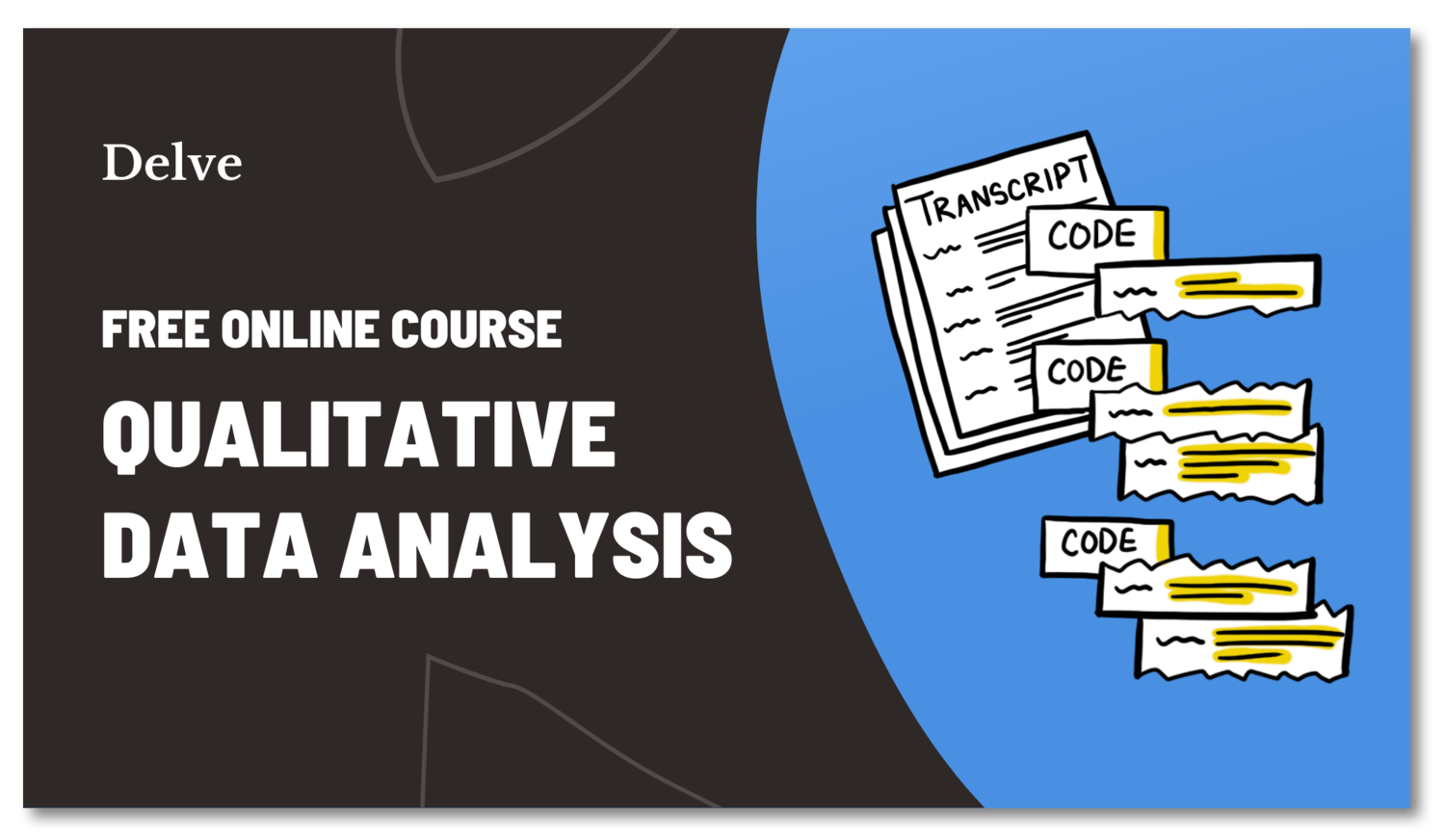
Pattern Coding Example

Let's tie all this together with a step-by-step example of pattern coding. We’ll focus on how Saldaña developed the pattern code "Dysfunctional Direction" we used earlier, and how this process leads towards a deeper understanding of what's going on the data.
1. Review your initial codes
Start by reviewing your first-cycle codes from staff interviews. In our example, these included:
First-Cycle Codes: Employee Satisfaction Study
Code: Unclear Instructions
Description: Vague directives leading to confusion and errors.
Code: Rushed Directions
Description: Hastily conveyed information causing misunderstandings.
Code: Incomplete Directions
Description: Instructions are incomplete, requiring clarification.
Code: Expectation of Information
Description: Assumption that employees should know missing details.
Code: She Doesn't Communicate
Description: Leadership is perceived as not communicating enough.
Code: Written Directions Needed
Description: Requests for written instructions to clarify verbal ones.
Code: You Never Told Me
Description: Frustration caused by perceived information gaps.
You want to read through these codes several times, noting any initial thoughts or connections. Keeping analytical memos is a great way to keep track of your thought process and develop ideas.
⏳ Coding Tip: Attaching memos to your initial codes helps capture thoughts and develop your pattern codes. Delve links memos directly to codes, making it easier to reel in scattered ideas and keep your thought process on track.
2. Group similar codes
Now you start clustering your codes to identify possible "meta-codes;" the patterns, trends or commonalities you think matter most.
At this stage, you want to ask yourself questions like:
Which codes show up frequently?
Do some codes relate to the same idea?
Is there a common underlying issue?
Many of the initial codes seem to relate to communication problems, particularly about information coming from management. At this stage you might notice that codes like "You Never Told Me" and "Rushed Directions" often appear together. This co-occurrence can hint at a larger issue.
As you group codes, keep recording memos about your thoughts and decisions. These memos help you track the development of your pattern codes. For example, you might write:
"The recurring theme of unclear and incomplete instructions ( "You Never Told Me," "Rushed Directions" ) suggests a pattern of ' Dysfunctional Direction,’ meaning management consistently fails to provide clear communication, leading to employee frustration."
⏳ Coding Tip: CAQDAS like Delve offer data filtering , drag-and-drop coding , and data visualization tools , all features that make it more time-efficient to uncover these underlying connections.
3. Define pattern codes
Now, you actually assign a pattern code (or "meta-code") to those clusters that captures something important about your data.
When creating your pattern codes, you’re using the trio of options Saldaña suggests: themes, explanations, and relationships among people or groups. For Dysfunctional Direction:
Pattern Code: Dysfunctional Direction
Description: This pattern code synthesizes several complaints to identify a systemic issue with leadership and communication in the workplace.
4. Iterate and refine
Continuously review and adjust your codes. Go back over your pattern codes to confirm they reflect your data. This might involve:
Re-assessing Data Segments : Confirm that each initial code fits well within the pattern code and isn’t repeating ideas.
Seeking Feedback : Discuss your findings with colleagues through peer debriefing or team members for additional perspectives.
Adjusting as Needed : You might find that some codes fit better elsewhere. For instance, "Expectations of Information" might work better under a different pattern code like "Lack of Transparency."
💡 Best Practice: Keep a log of your coding decisions and changes in your memos. This audit trail helps maintain the rigor of your analysis and can be invaluable when writing up your findings.
5. Visualize relationships & patterns
In this final step, map out how all your patterns connect. Go back to your diagrams or matrices to visually represent relationships between your pattern codes.
This step helps identify complex interactions and potential areas for further investigation. You can explore data segments where "Dysfunctional Direction" co-occurs with other pattern codes like "Employee Morale" or "Project Delays." This type of pattern could help reveal other ways that communication issues are affecting other parts of the workplace
💡 Best Practice: Create a visual representation of your codes, such as a co-occurrence matrix, mind map, or clustered sticky notes written out by hand. This can help you identify relationships and groupings without getting overwhelmed.
For Example:
- Find Co-occurrences: Where do "Dysfunctional Direction" and "Employee Morale" appear together?
- Explore Alternatives: Identify segments where either "Dysfunctional Direction" or "Project Delays" are coded.
- Exclude Irrelevant Data: Focus on segments with "Dysfunctional Direction" but not "Employee Satisfaction."
As you go through this process, you're organizing what will likely become the cornerstone of your final results. That will include explaining and referencing the matrices or note cards or any other tools that you’ve used along the way. Remember, pattern coding is an iterative process. You'll refine your codes several times, each pass deepening your understanding of the data. While it can be time-consuming, the insights gained make it a key step in qualitative analysis.
⏳ Delve Tip: Delve’s filtering tools make it easy to focus on specific segments. For example, find where "Dysfunctional Direction" overlaps with "Employee Morale," or identify sections with "Project Delays" but no mention of "Leadership Issues." Use "and," "or," and "not" to fine-tune your search and uncover deeper insights.
Challenges and Tools for Pattern Coding

Pattern coding is a powerful tool that requires synthesizing and organizing insights from your initial coding phase. However, grouping codes , avoiding oversimplification , managing complex relationships between codes , and determining the right time to transition from initial coding can cause a lot of issues.
❌ Challenges with Pattern Coding
At this secondary stage of analysis, pattern coding can be both powerful and tricky. The goal is to weave together data in a way that enhances your overall narrative without losing sight of important details. Common roadblocks include:
Grouping Codes Effectively: Figuring out how to group codes in the most meaningful way can feel like piecing together a complex puzzle. Missteps here can obscure valuable insights or lead to irrelevant groupings.
Risk of Oversimplifying: When combining codes into broader themes, there’s a danger of watering down the nuances within the data. Oversimplification can flatten the richness of your findings, causing you to miss out on key subtleties.
Managing Complex Relationships: It’s not just about connecting the dots between individual codes—it's about keeping track of how these codes relate to each other. This is where things get messy if you're not using the right tools to manage complex relationships within the data.
Knowing When to Start: Jumping into pattern coding too early—or stopping your initial coding phase prematurely—can result in a shallow analysis. You need a solid foundation of first-cycle codes before diving deeper into pattern identification.
Given these challenges, finding the right tools to support your pattern coding process is essential. Let’s explore some options that can help you navigate this creative yet complex stage of analysis.
💡 Coding Tip: Delve offers a range of features to help you navigate pattern coding challenges:
- Data Filtering: Use logical operators like "and," "or," and "not" to focus on co-occurrences or exclude irrelevant data.
- Visualize Relationships: See how different codes interact with data visualization tools to manage complex relationships.
- Drag-and-Drop Coding: Organize and group codes quickly, refining them as your analysis evolves.
- Memos and Notes: Attach memos to codes to track your reasoning and keep everything organized.
- Collaborative Features: Work with your team in real time to stay aligned throughout the process.
Tools for Pattern Coding
When it’s time to tackle pattern coding, the right tools can make all the difference. While we’ve touched on some ways CAQDAS can enhance your process, there are other options to consider depending on your workflow.
1. PEN AND PAPER
Using highlighters and sticky notes is a great start. You may find writing out codes on notecards helps you quickly compare different clustering techniques. However, this method can be messy and quickly gets unwieldy if you have a large amount of separate codes to deal with.
- Using notecards or a visual tool helps you quickly move and reorder codes all within eyesight.
- Difficult to reorganize or group codes as new patterns emerge
- Limited space for writing detailed explanations of pattern codes
- Near-impossible to efficiently track relationships across multiple data sources
2. WORD DOCUMENTS
Word processors like Microsoft Word are another option. They let you add comments and memos directly to your transcripts. While this approach might appear more flexible than pen and paper, it’s quite challenging for pattern coding where you’re moving in and out of dozens or hundreds of separate codes.
- Adding comments and memos to your pattern codes helps you keep track of your decisions.
- Updating or merging pattern codes across multiple documents is time-consuming and error-prone
- Difficult to visualize relationships between codes and emerging patterns
- Limited ability to track the evolution of pattern codes over time
3. EXCEL SHEETS
Excel and other spreadsheet programs have some benefits compared to pen and paper or word processors. They can track codes and generate basic statistics when properly configured. However, their rigid structure can hinder the flexible, exploratory nature of pattern coding.
- You can track codes and generate basic stats to help you monitor code usage and identify possible patterns.
- Rigid format can hinder the fluid nature of pattern coding
- Difficult to capture complex relationships between codes and patterns
- Limited support for transitioning to more advanced analytical stages
4. QUALITATIVE ANALYSIS TOOLS
Recognizing the limitations of traditional methods, specialized CAQDAS tools like Delve offer features tailored to the pattern coding process. Delve stands out for this process by providing:
Flexible Code Organization : Easily drag, drop, group, merge, and reorganize codes as you develop patterns.
Visualization of Relationships : Generate simple co-occurrence matrices that provide clear overviews of how codes and patterns are distributed across your dataset.

Flexible Data Views: Delve’s intuitive interface lets you filter, merge, and split codes dynamically, giving you more control as your analysis evolves from initial coding to pattern recognition.

Collaborative Features : Real-time collaboration capabilities for team-based analysis. including the option to hide others work to avoid outside influence on your coding or to compare team members code side by side.

While traditional methods may seem accessible at first, they often fall short as your pattern coding becomes more complex . Manually sorting through hundreds of codes or sprawling excel sheets can take weeks, and you’ll often miss key patterns in the data. This is a common issue if you rely on outdated methods like Microsoft Word, Excel or pen and paper.
Do these issues sound familiar? Enter Delve : a powerful pattern coding alternative, providing the flexibility and functionality needed to conduct effective pattern coding and develop meaningful insights from your data.
The Best Tool For Pattern Coding: Delve

Pattern coding is designed for connecting analytical dots and distilling scattered codes. However, like most qualitative methods, it comes with the challenges we’ve covered: picking how to group codes , avoiding oversimplification , and managing relationships between codes all present potential hurdles – among others .
With Delve , you eliminate huge parts of these issues right away. You can quickly organize, rearrange, tag, and visualize your codes, ensuring every insight is captured and connected. Whether you are working solo or part of a team, you’re able to dig deeper into your data with Delve.
Last Word on Pattern Coding
Pattern coding helps you turn dozens or even hundreds of scattered codes and ideas into coherent themes. It accelerates theory development and reveals hidden connections. However, its true potential is unlocked when paired with the right coding tools.
By simplifying organization, enhancing collaboration, and providing powerful visualization tools, Delve empowers you to extract even richer and more meaningful insights from your data – with unprecedented ease and precision.
Saldana, Johnny (2009). The Coding Manual for Qualitative Researchers . Thousand Oaks, California: Sage.
Braun, V., & Clarke, V. (2021). Thematic Analysis: A Practical Guide . Sage Publications.
Cite this blog post:
Delve, Ho, L., & Limpaecher, A. (2024, October 21). How to do Pattern Coding in Qualitative Research . Practical Guide to Grounded Theory . https://delvetool.com/blog/pattern-coding

Want to create or adapt books like this? Learn more about how Pressbooks supports open publishing practices.
Chapter 10: Qualitative Data Collection & Analysis Methods
10.6 Qualitative Coding, Analysis, and Write-up: The How to Guide
This section provides an abbreviated set of steps and directions for coding, analyzing, and writing up qualitative data, taking an inductive approach. The following material is adapted from Research Rundowns, retrieved from https://researchrundowns.com/qual/qualitative-coding-analysis/ .
Step 1: Open Coding
At this first level of coding, the researcher is looking for distinct concepts and categories in the data, which will form the basic units of the analysis. In other words, the researcher is breaking down the data into first level concepts, or master headings, and second-level categories, or subheadings.
Researchers often use highlighters to distinguish concepts and categories. For example, if interviewees consistently talk about teaching methods, each time an interviewee mentions teaching methods, or something related to a teaching method, the researcher uses the same colour highlight. Teaching methods would become a concept, and other things related (types, etc.) would become categories – all highlighted in the same colour. It is valuable to use different coloured highlights to distinguish each broad concept and category. At the end of this stage, the transcripts contain many different colours of highlighted text. The next step is to transfer these into a brief outline, with main headings for concepts and subheadings for categories.
Step 2: Axial (Focused) Coding
In open coding, the researcher is focused primarily on the text from the interviews to define concepts and categories. In axial coding, the researcher is using the concepts and categories developed in the open coding process, while re-reading the text from the interviews. This step is undertaken to confirm that the concepts and categories accurately represent interview responses.
In axial coding, the researcher explores how the concepts and categories are related. To examine the latter, you might ask: What conditions caused or influenced concepts and categories? What is/was the social/political context? What are the associated effects or consequences? For example, let us suppose that one of the concepts is Adaptive Teaching , and two of the categories are tutoring and group projects . The researcher would then ask: What conditions caused or influenced tutoring and group projects to occur? From the interview transcripts, it is apparent that participants linked this condition (being able to offer tutoring and group projects) with being enabled by a supportive principle. Consequently, an axial code might be a phrase like our principal encourages different teaching methods . This discusses the context of the concept and/or categories and suggests that the researcher may need a new category labeled “supportive environment.” Axial coding is merely a more directed approach to looking at the data, to help make sure that the researcher has identified all important aspects.
Step 3: Build a Data Table
Table 10.4 illustrates how to transfer the final concepts and categories into a data table. This is a very effective way to organize results and/or discussion in a research paper. While this appears to be a quick process, it requires a lot of time to do it well.
Table 10.4 Major categories and associated concept
Step 4: Analysis & Write-Up
Not only is Table 10.4 an effective way to organize the analysis, it is also a good approach for assisting with the data analysis write-up. The first step in the analysis process is to discuss the various categories and describe the associated concepts. As part of this process, the researcher will describe the themes created in the axial coding process (the second step).
There are a variety of ways to present the data in the write-up, including: 1) telling a story; 2) using a metaphor; 3) comparing and contrasting; 4) examining relations among concepts/variables; and 5) counting. Please note that counting should not be a stand-alone qualitative data analysis process to use when writing up the results, because it cannot convey the richness of the data that has been collected. One can certainly use counting for stating the number of participants, or how many participants spoke about a specific theme or category; however, the researcher must present a much deeper level of analysis by drawing out the words of the participants, including the use of direct quotes from the participants´ interviews to demonstrate the validity of the various themes.
Here are some resources for demonstrations on other methods for coding qualitative data:
- Qualitative Data Analysis [PDF]
When writing up the analysis, it is best to “identify” participants through a number, alphabetical letter, or pseudonym in the write-up (e.g. Participant #3 stated …). This demonstrates that you drawing data from all of the participants. Think of it this way, if you were doing quantitative analysis on data from 400 participants, you would present the data for all 400 participants, assuming they all answered a specific question. You will often see in a table of quantitative results (n=400), indicating that 400 people answered the question. This is the researcher’s way of confirming, to the reader, how many participants answered a particular research question. Assigning participant numbers, letters, or pseudonyms serves the same purpose in qualitative analysis.
Research Methods for the Social Sciences: An Introduction Copyright © 2020 by Valerie Sheppard is licensed under a Creative Commons Attribution-NonCommercial-ShareAlike 4.0 International License , except where otherwise noted.
Share This Book

Coding Qualitative Data: A Beginner’s How-To + Examples

When gathering feedback, whether it’s from surveys , online reviews, or social mentions , the most valuable insights usually come from free-form or open-ended responses.
Though these types of responses allow for more detailed feedback, they are also difficult to measure and analyse on a large scale. Coding qualitative data allows you to transform these unique responses into quantitative metrics that can be compared to the rest of your data set.
Read on to learn about this process.
What is Qualitative Data Coding?
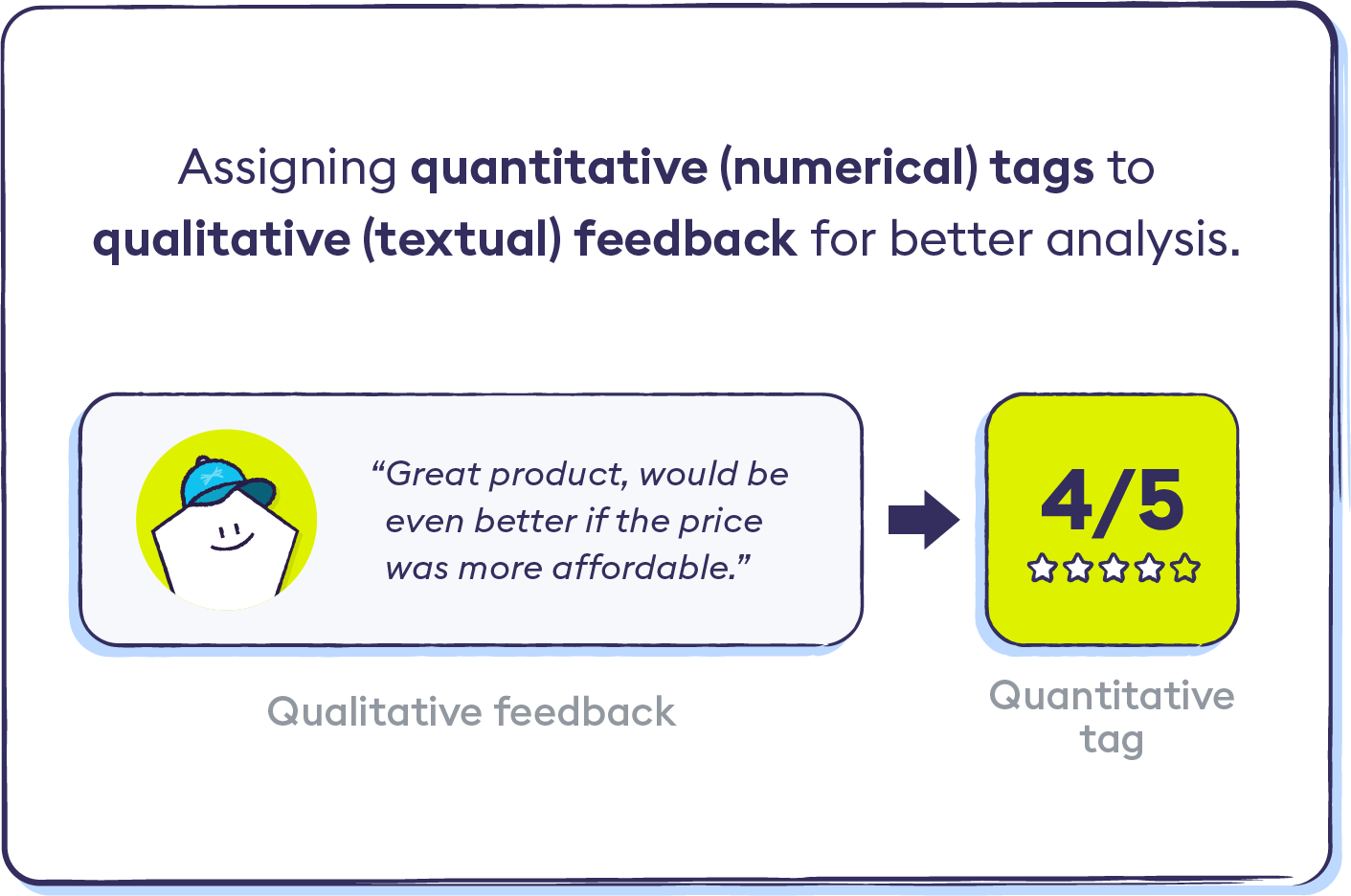
Qualitative data coding is the process of assigning quantitative tags to the pieces of data. This is necessary for any type of large-scale analysis because you 1) need to have a consistent way to compare and contrast each piece of qualitative data, and 2) will be able to use tools like Excel and Google Sheets to manipulate quantitative data.
For example, if a customer writes a Yelp review stating “The atmosphere was great for a Friday night, but the food was a bit overpriced,” you can assign quantitative tags based on a scale or sentiment. We’ll get into how exactly to assign these tags in the next section.
Inductive Coding vs Deductive Coding
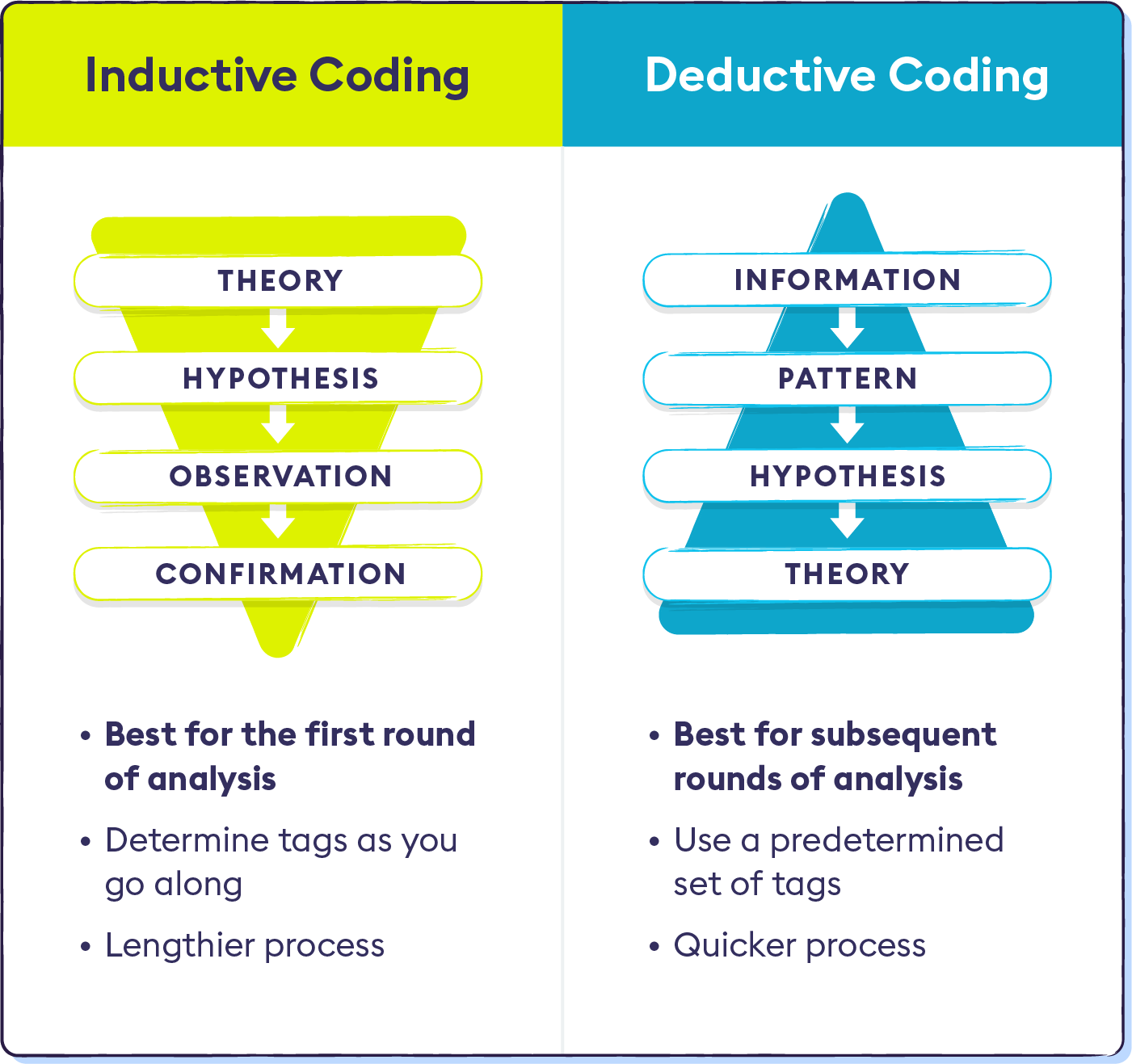
When deciding how you will scale and code your data, you’ll first have to choose between the inductive or deductive methods. We cover the pros and cons of each method below.
Inductive Coding
Inductive coding is when you don’t already have a set scale or measurement with which to tag the data. If you’re analysing a large amount of qualitative data for the first time, such as the first round of a customer feedback survey, then you will likely need to start with inductive coding since you don’t know exactly what you will be measuring yet.
Inductive coding can be a lengthy process, as you’ll need to comb through your data manually. Luckily, things get easier the second time around when you’re able to use deductive coding.
Deductive Coding
Deductive coding is when you already have a predetermined scale or set of tags that you want to use on your data. This is usually if you’ve already analysed a set of qualitative data with inductive reasoning and want to use the same metrics.
To continue from the example above, say you noticed in the first round that a lot of Yelp reviews mentioned the price of food, and, using inductive coding, you were able to create a scale of 1-5 to measure appetisers, entrees, and desserts.
When analysing new Yelp reviews six months later, you’ll be able to keep the same scale and tag the new responses based on deductive coding, and therefore compare the data to the first round of analysis.
3 Steps for Coding Qualitative Data From the Top-Down
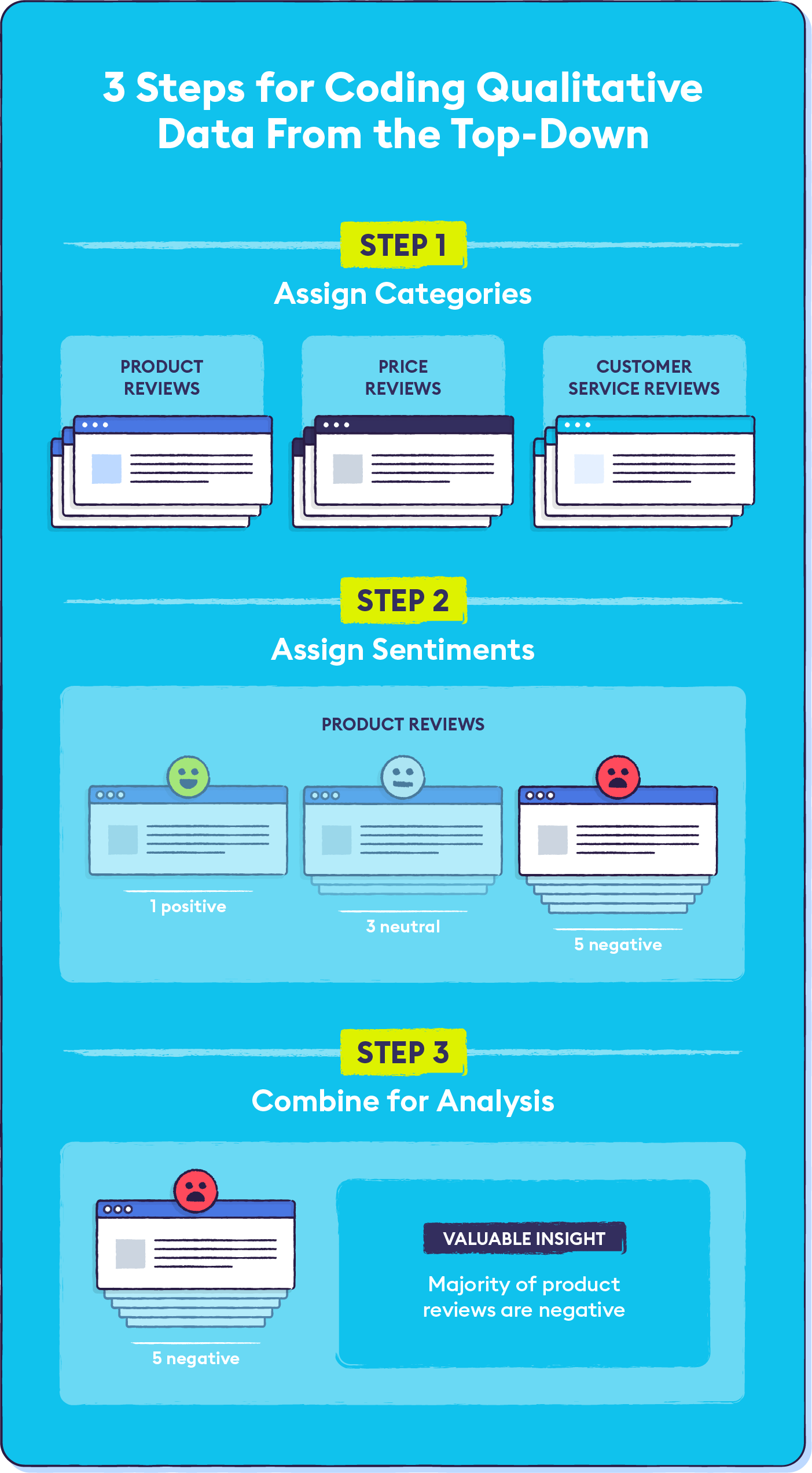
For this section, we will assume that we’re using inductive coding.
1. Start with Broad Categories
The first thing you will want to do is sort your data into broad categories. Think of each of these categories as specific aspects you want to know more about.
To continue with the restaurant example, your categories could include food quality, food price, atmosphere, location, service, etc.
Or for a business in the B2B space, your categories could look something like product quality, product price, customer service, chatbot quality, etc.
2. Assign Emotions or Sentiments
The next step is to then go through each category and assign a sentiment or emotion to each piece of data. In the broadest terms, you can start with just positive emotion and negative emotion.
Remember that when using inductive coding, you’re figuring out your scale and measurements as you go, so you can always start with broad analysis and drill down deeper as you become more familiar with your data.
3. Combine Categories and Sentiments to Draw Conclusions
Once you’ve sorted your data into categories and assigned sentiments, you can start comparing the numbers and drawing conclusions.
For example, perhaps you see that out of the 500 Yelp reviews you’ve analysed, 300 fall into the food price/negative sentiment section of your data. That’s a pretty clear indication that customers think your food is too expensive, and you may see an improvement in customer retention by dropping prices.
The three steps outlined above cover just the very basics of coding qualitative data, so you can understand the theory behind the analysis.
In order to gain more detailed conclusions, you’ll likely need to dig deeper into the data by assigning more complex sentiment tags and breaking down the categories further. We cover some useful tips and a coding qualitative data example below.
4 Tips to Keep in Mind for Accurate Qualitative Data Coding
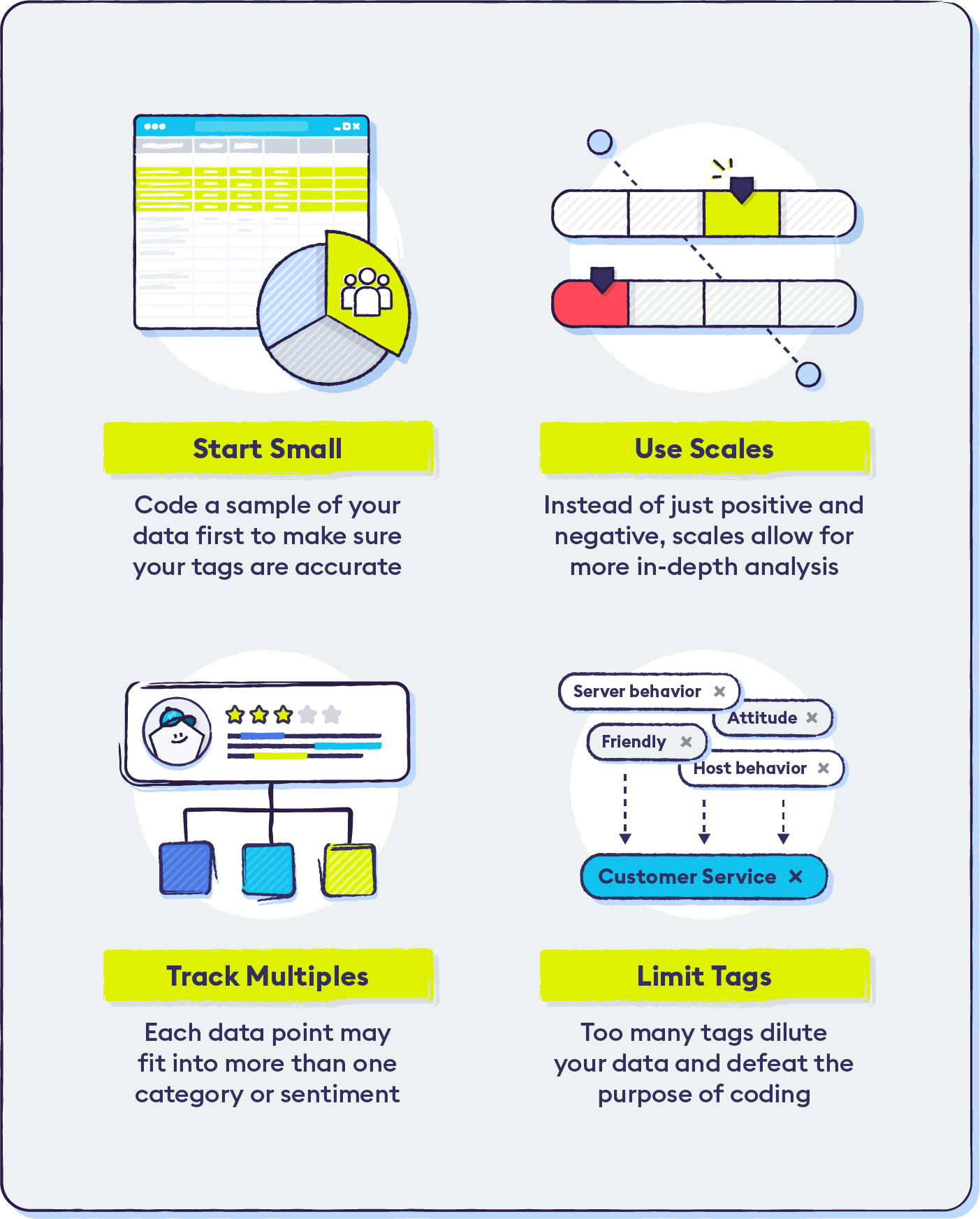
Here are some helpful reminders to keep on hand when going through the three steps outlined above.
1. Start with a Small Sample of the Data
You’ll want to start with a small sample of your data to make sure the tags you’re using will be applicable to the rest of the set. You don’t want to waste time by going through and manually tagging each piece of data, only to realise at the end that the tags you’ve been using actually aren’t accurate.
Once you’ve broken up your qualitative data into the different categories, choose 10-20% of responses in each category to tag using inductive coding.
Then, continue onto the analysis phase using just that 10-20%.
If you’re able to find takeaways and easily compare the data with that small sample size , then you can continue coding the rest of the data in that same way, adding additional tags where needed.
2. Use Numerical Scales for Deeper Analysis
Instead of just assigning positive and negative sentiments to your data points, you can break this down even further by utilising numerical scales.
Exactly how negative or how positive was the piece of feedback? In the Yelp review example from the beginning of this article, the reviewer stated that the food was “a bit overpriced.” If you’re using a scale of 1-5 to tag the category “food price,” you could tag this as a ⅗ rating.
You’ll likely need to adjust your scales as you work through your initial sample and get a clearer picture of the review landscape.
Having access to more nuanced data like this is important for making accurate decisions about your business.
If you decided to stick with just positive and negative tags, your “food price” category might end up being 50% negative, indicating that a massive change to your pricing structure is needed immediately.
But if it turns out that most of those negative reviews are actually ⅗’s and not ⅕’s, then the situation isn’t as dire as it might have appeared at first glance.
3. Remember That Each Data Point Can Contain Multiple Pieces of Information
Remember that qualitative data can have multiple sentiments and multiple categories (such as the Yelp review example mentioning both atmosphere and price), so you may need to double or even triple-sort some pieces of data.
That’s the beauty of and the struggle with handling open-ended or free-form responses.
However, these responses allow for more accurate insights into your business vs narrow multiple-choice questions.
4. Be Mindful of Having Too Many Tags
Remember, you’re able to draw conclusions from your qualitative data by combining category tags and sentiment tags.
An easy mistake for data analysis newcomers to make is to end up with so many tags that comparing them becomes impossible. This usually stems from an overabundance of caution that you’re tagging responses accurately.
For example, say you’re tagging a review that’s discussing a restaurant host’s behavior. You put it in the category “host/hostess behavior” and tag it as a ⅗ for the sentiment.
Then, you come across another review discussing a server’s behaviour that’s slightly more positive, so you tag this as “server behaviour” for the category and 3.75/5 for the sentiment.
By getting this granular, you’re going to end up with very few data points in the same category and sentiment, which defeats the purpose of coding qualitative data.
In this example, unless you’re very specifically looking at the behaviour of individual restaurant positions, you’re better off tagging both responses as “customer service” for the category and ⅗ for the sentiment for consistency’s sake.
Coding Qualitative Data Example
Below we’ll walk through an example of coding qualitative data, utilising the steps and tips detailed above.
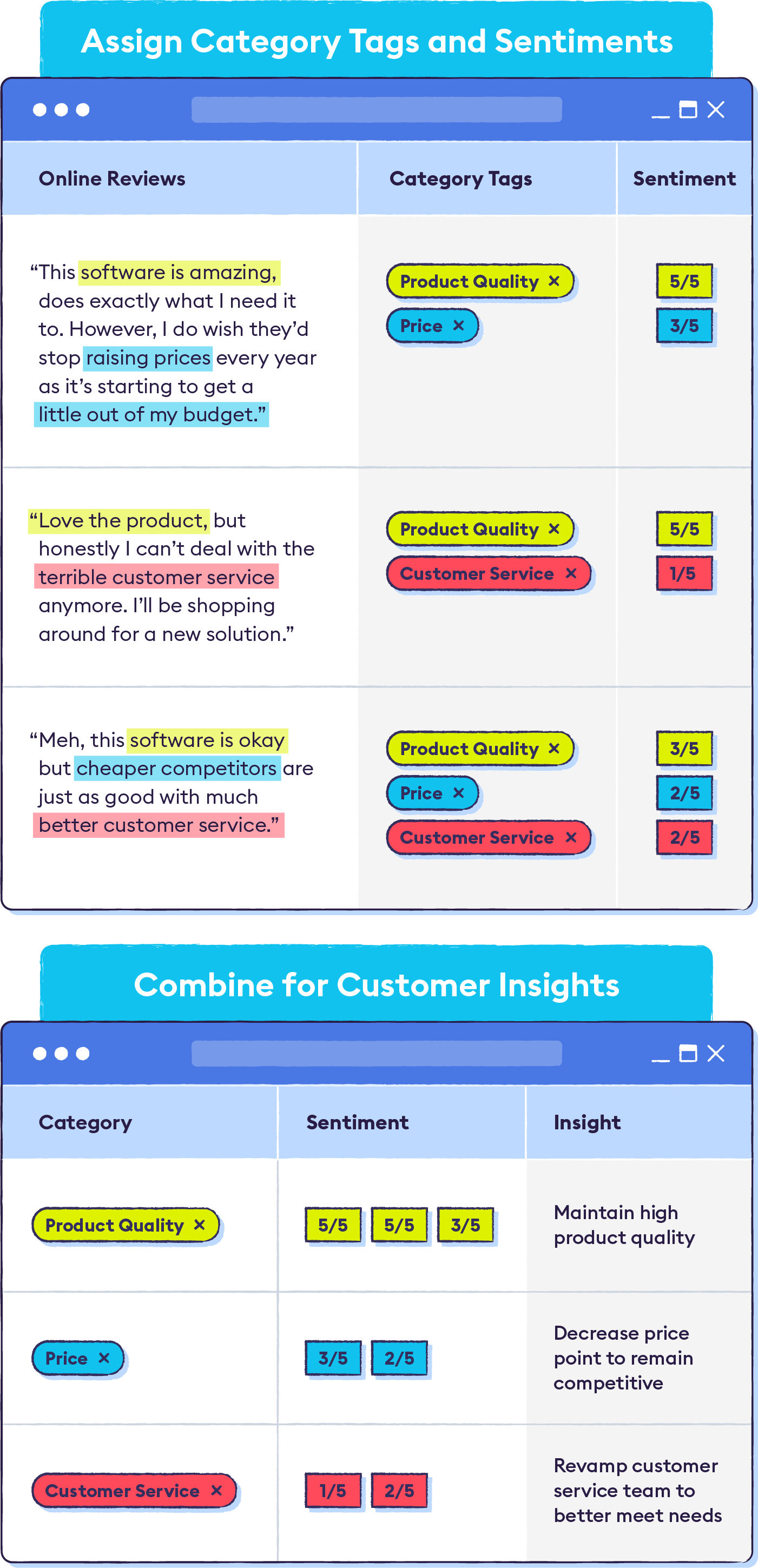
Step 1: Read through your data and define your categories. For this example, we’ll use “customer service,” “product quality,” and “price.”
Step 2: Sort a sample of the data into the above categories. Remember that each data point can be included in multiple categories.
- “This software is amazing, does exactly what I need it to [Product Quality]. However, I do wish they’d stop raising prices every year as it’s starting to get a little out of my budget [Price].”
- “Love the product [Product Quality], but honestly I can’t deal with the terrible customer service anymore [Customer Service]. I’ll be shopping around for a new solution.”
- “Meh, this software is okay [Product Quality] but cheaper competitors [Price] are just as good with much better customer service [Customer Service].”
Step 3: Assign sentiments to the sample. For more in-depth analysis, use a numerical scale. We’ll use 1-5 in this example, with 1 being the lowest satisfaction and 5 being the highest.
- Product Quality:
- “This software is amazing, does exactly what I need it to do” [5/5]
- “Love the product” [5/5]
- “Meh, this software is okay [⅖]
- Customer Service:
- “Honestly I can’t deal with the terrible customer service anymore [⅕]
- “...Much better customer service,” [⅖]
- “However, I do wish they’d stop raising prices every year as it’s starting to get a little out of my budget.” [⅗]
- “Cheaper competitors are just as good.” [⅖]
Step 4: After confirming that the established category and sentiment tags are accurate, continue steps 1-3 for the rest of your data, adding tags where necessary.
Step 5: Identify recurring patterns using data analysis. You can combine your insights with other types of data , like demographic and psychographic customer profiles.
Step 6: Take action based on what you find! For example, you may discover that customers aged 20-30 were the most likely to provide negative feedback on your customer service team, equating to ⅖ or ⅕ on your coding scale. You may be able to conclude that younger customers need a more streamlined way to communicate with your company, perhaps through an automated chatbot service.
Step 7: Repeat this process with more specific research goals in mind to continue digging deeper into what your customers are thinking and feeling . For example, if you uncover the above insight through coding qualitative data from online reviews, you could send out a customer feedback survey specifically asking free-form questions about how your customers would feel interacting with a chatbot instead.
How AI tools help with Coding Qualitative Data
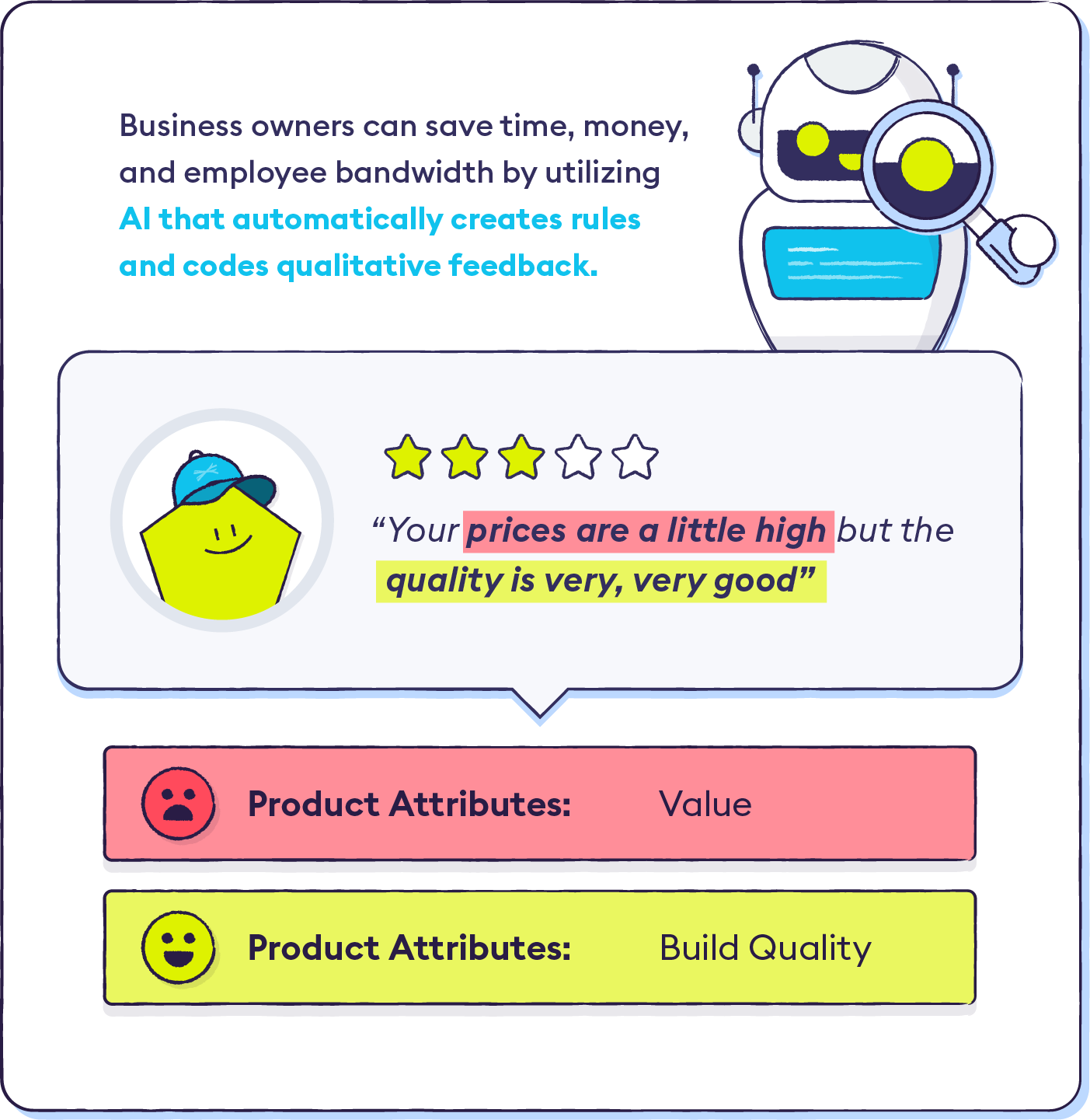
Now that you understand the work that goes into coding qualitative data, you’re probably wondering if there’s an easier solution than manually sorting through every response.
The good news is that, yes, there is. Advanced AI-backed tools are available to help companies quickly and accurately analyse qualitative data at scale, such as customer surveys and online reviews.
These tools can not only code data based on a set of rules you determine, but they can even do their own inductive coding to determine themes and create the most accurate tags as they go.
These capabilities allow business owners to make accurate decisions about their business based on actual data and free up the necessary time and employee bandwidth to act on these insights.
The infographic below gives a visual summary of how to code qualitative data and why it’s essential for businesses to learn how:

Try Chattermill today today to learn how our AI-powered software can help you make smarter business decisions.
Related articles.

Introducing Chattermill’s Speech Analytics: Unlocking insights in every call
Now you can analyze support and sales calls directly within Chattermill

How Qonto Enhances Their Voice of the Customer Strategy with Speech Analytics
How Qonto leverages customer insights from voice data with Chattermill's Voice Analytics
.png)
Panel: How CX Can Drive Awareness and Word of Mouth
To get the outcomes you need from CX, your business needs to leverage use cases to create measurable impact.
See Chattermill in action
Understand the voice of your customers in realtime with Customer Feedback Analytics from Chattermill.

IMAGES
VIDEO
COMMENTS
A s we've discussed previously, qualitative research makes use of non-numerical data - for example, words, phrases or even images and video.To analyse this kind of data, the first dragon you'll need to slay is qualitative data coding (or just "coding" if you want to sound cool). But what exactly is coding and how do you do it?
Tips for manually coding qualitative data. Now that you know the basics of coding your qualitative data, here are some tips on making the most of your qualitative research. Use a codebook to keep track of your codes. As you code more and more data, it can be hard to remember all of your codes off the top of your head.
Before coding in qualitative research, you should decide if you want to start off with a set of codes and stick with them (deductive coding), come up with the codes as you read what you see in your data (inductive coding), or take a combination approach. ... Next, do further rounds of coding qualitative data to re-examine the codes and ...
Having pooled, their experience in coding qualitative material and teaching students how to code, in this paper, the authors synthesize the extensive literature on coding in the form of a hands-on ...
What is open coding in qualitative research Open coding is your first step in making sense of your data. It's about breaking down piles of data into manageable pieces and starting to identify salient patterns that really stick out to you. Corbin and Strauss paint the process as digging up "concepts, properties, and dimensions within the data ...
Ultimately, effective coding lays the foundation for meaningful analysis and contributes to richer findings in qualitative research. Initial Coding Techniques. Initial coding techniques are essential in qualitative research as they lay the groundwork for deeper analysis. These techniques allow researchers to break down vast amounts of data into ...
Understanding Where Pattern Coding Fits in the Qualitative Coding Process. Qualitative coding involves labeling and organizing non-numerical data like interviews or focus groups. Johnny Saldaña outlines a two-part process in "The Coding Manual for Qualitative Researchers" (2015), with pattern coding taking place in the second part of the ...
Deductive and Inductive Coding You create codes because you deem the identified topics/concepts/ideas as important and relevant to your study. Deductive Coding Codes emerge from your research question and/or the literature review. Inductive Coding Codes emerge through engagement with your actual data sources and/or data set.
Here are some resources for demonstrations on other methods for coding qualitative data: Qualitative Data Analysis [PDF] When writing up the analysis, it is best to "identify" participants through a number, alphabetical letter, or pseudonym in the write-up (e.g. Participant #3 stated …).
Step 7: Repeat this process with more specific research goals in mind to continue digging deeper into what your customers are thinking and feeling. For example, if you uncover the above insight through coding qualitative data from online reviews, you could send out a customer feedback survey specifically asking free-form questions about how ...